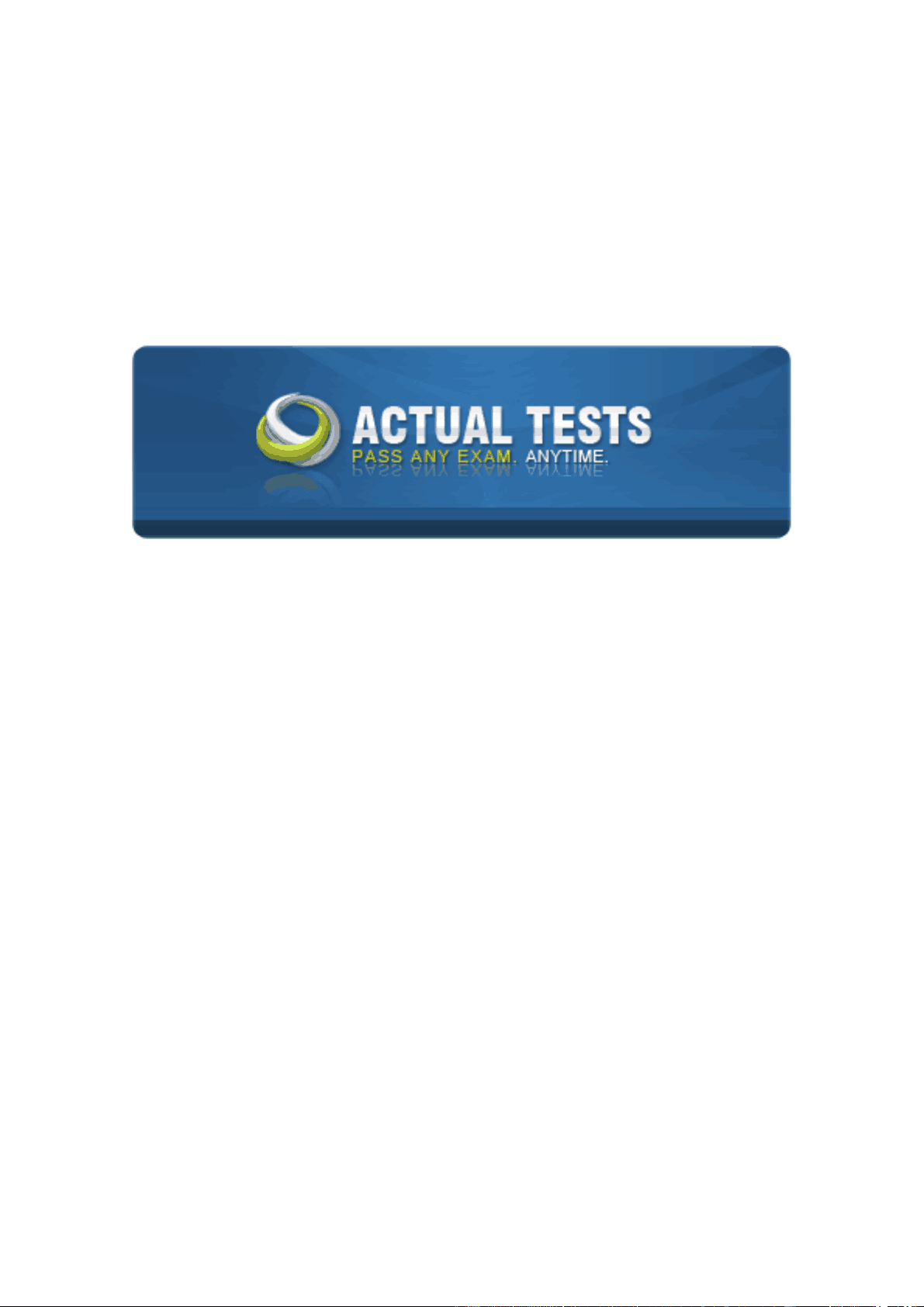
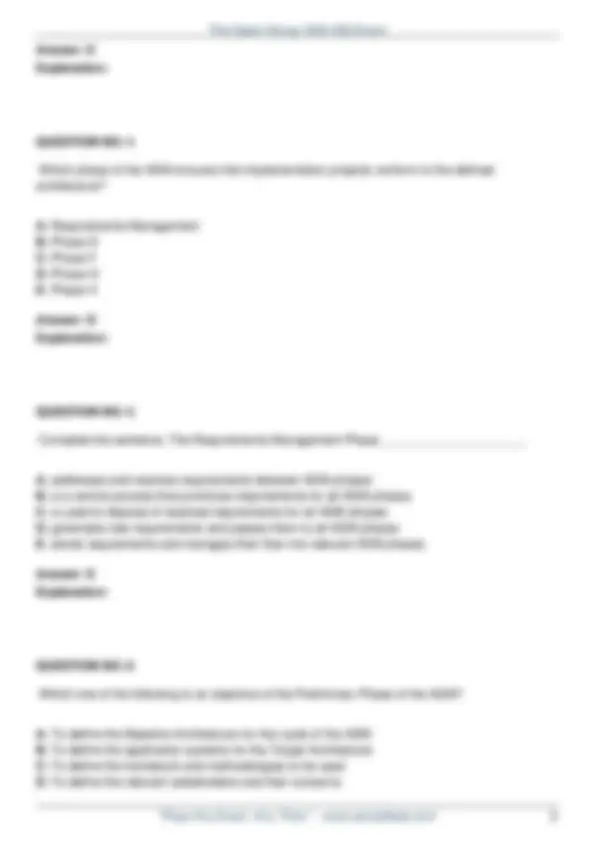
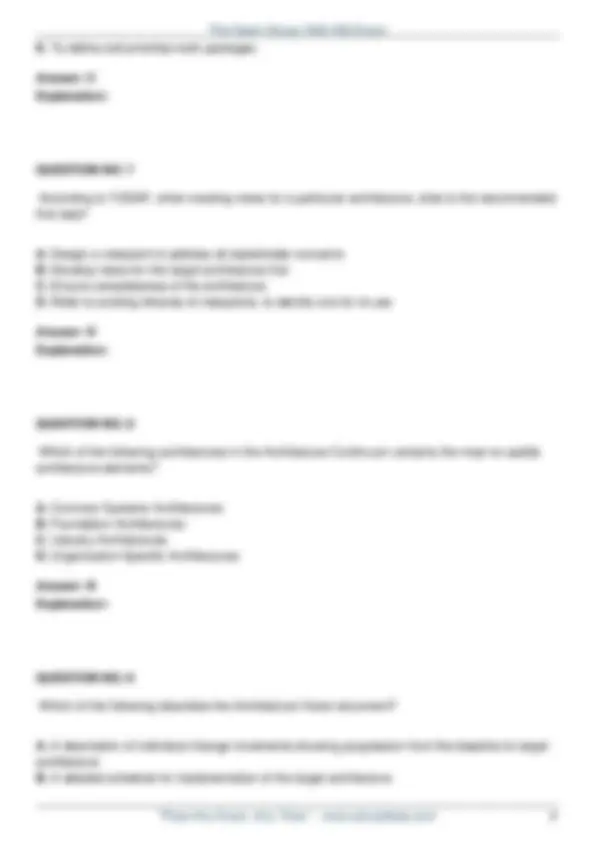
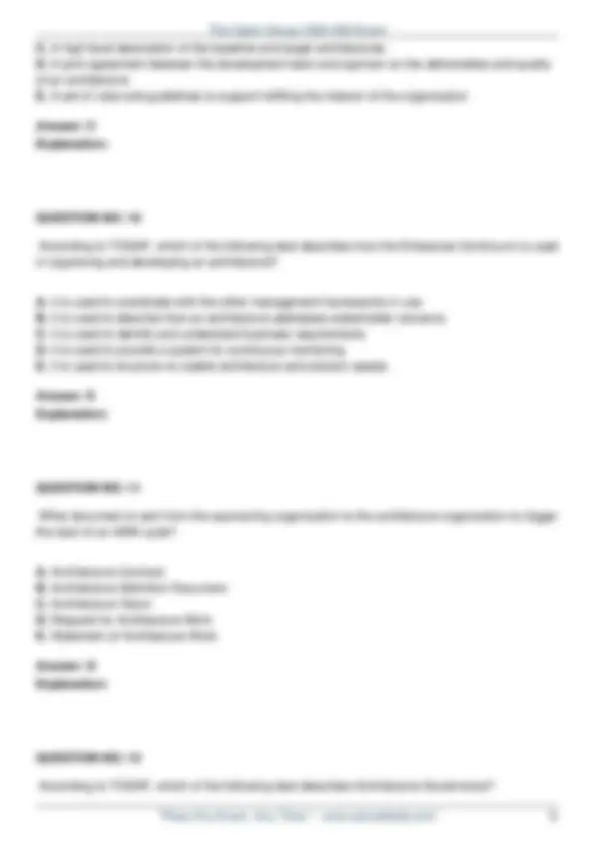
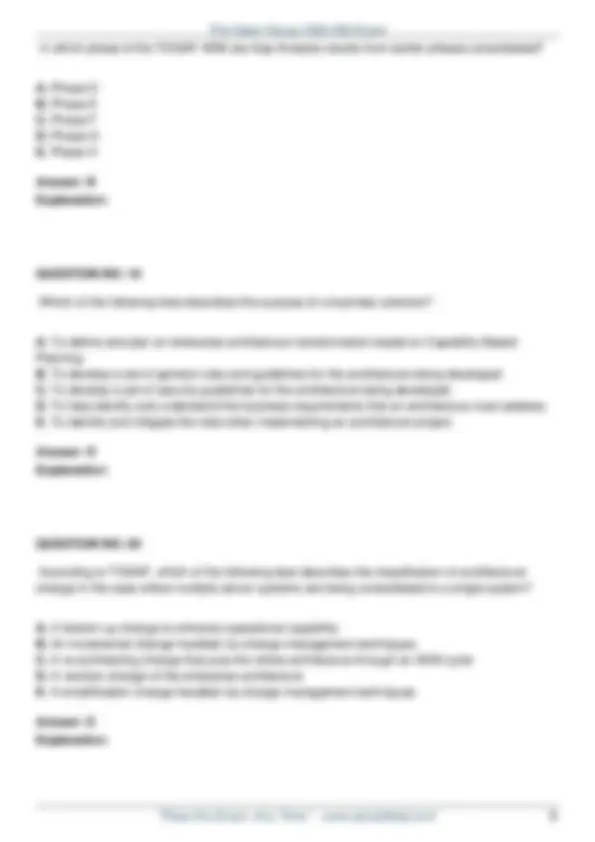
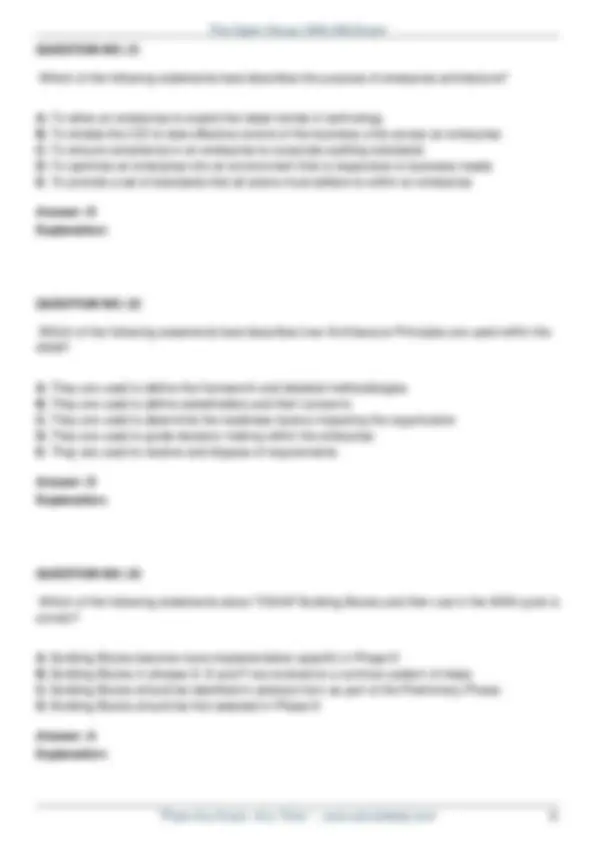
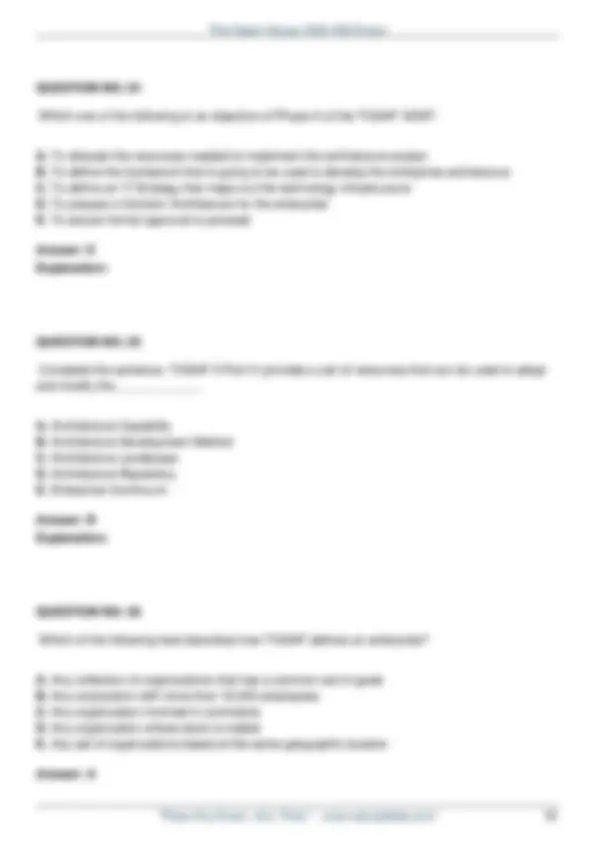
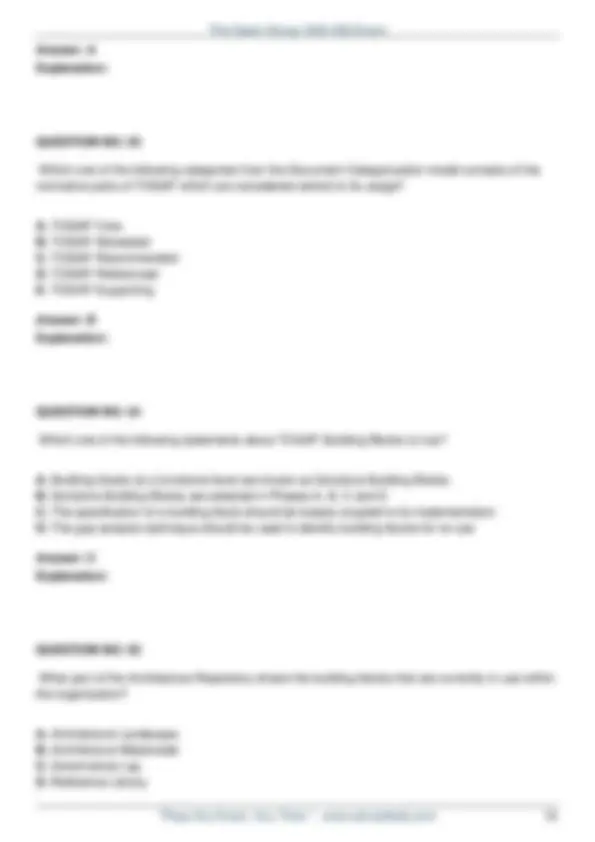
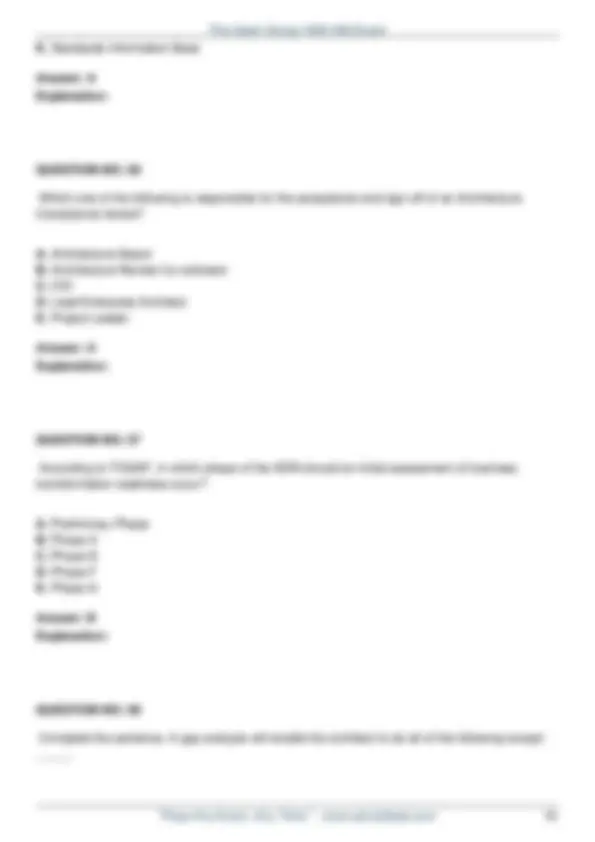
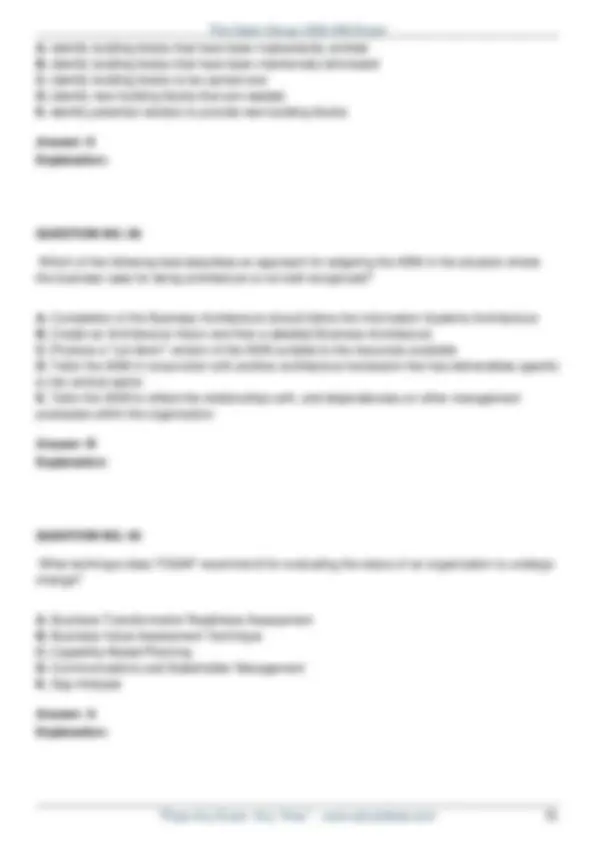
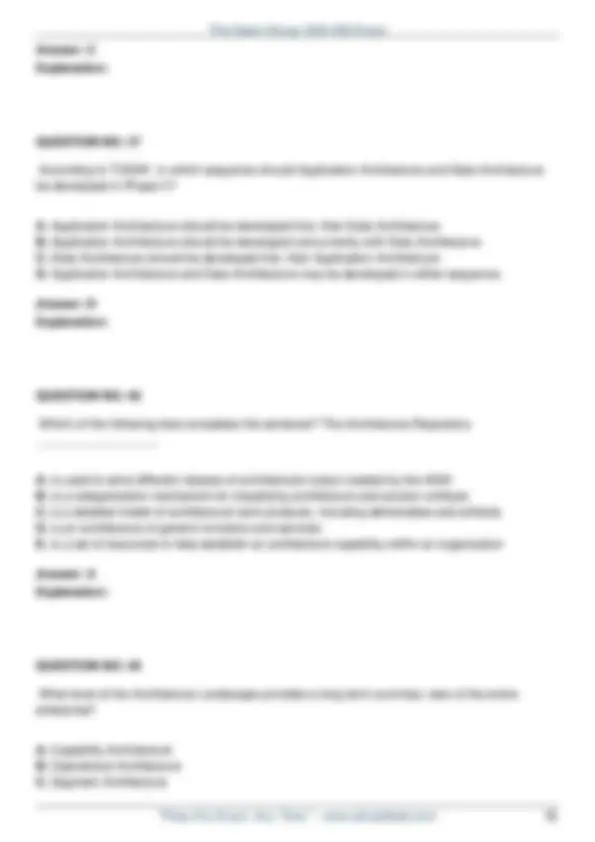
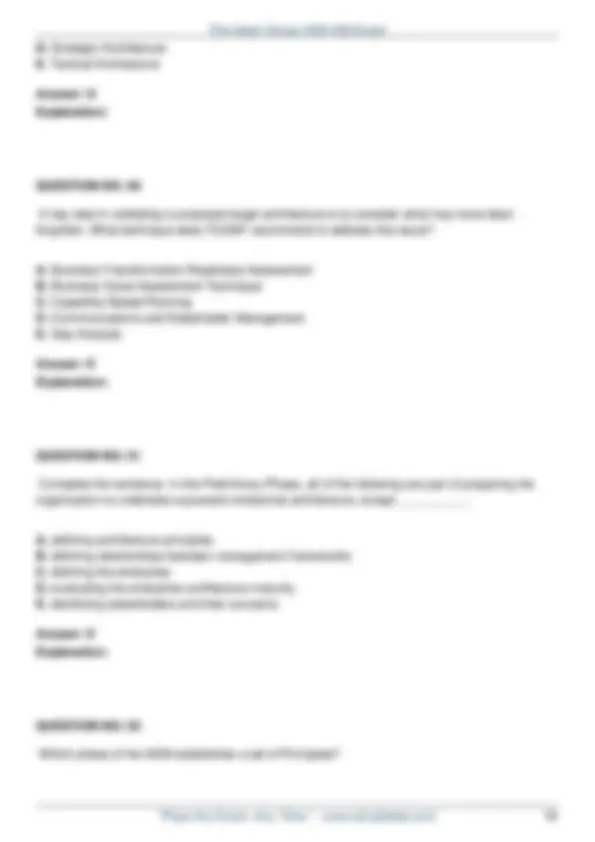
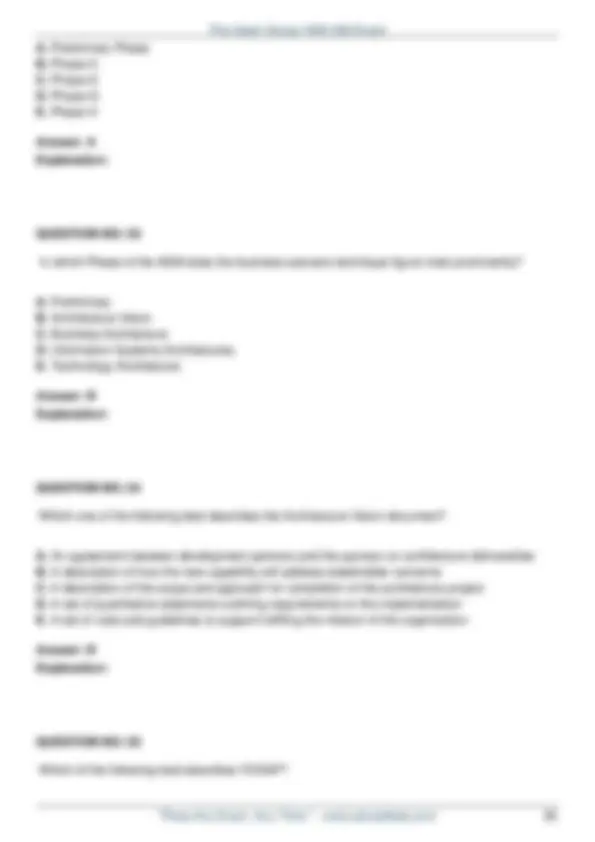
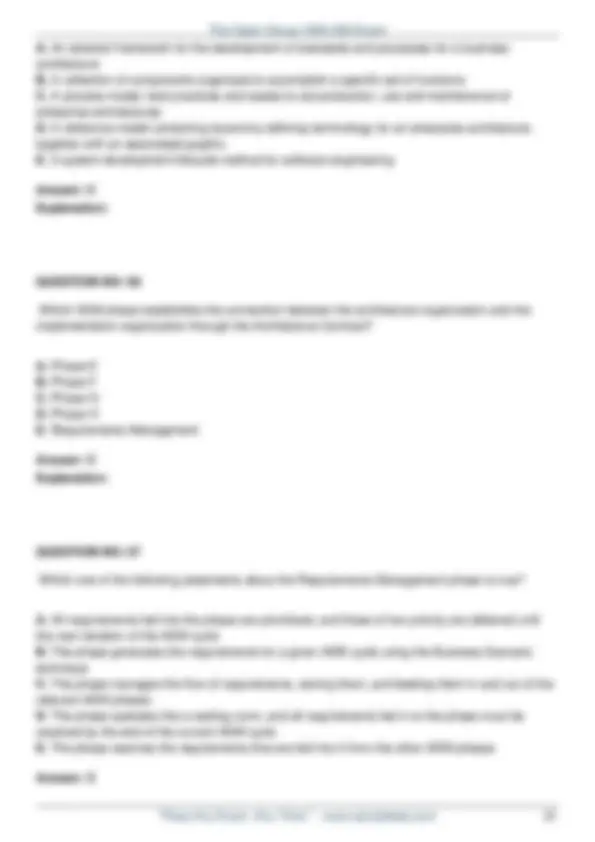
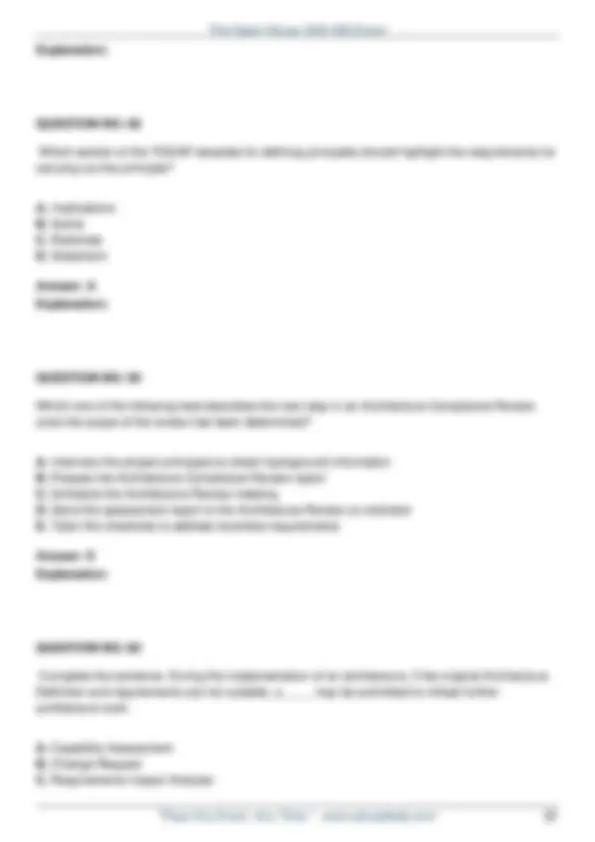
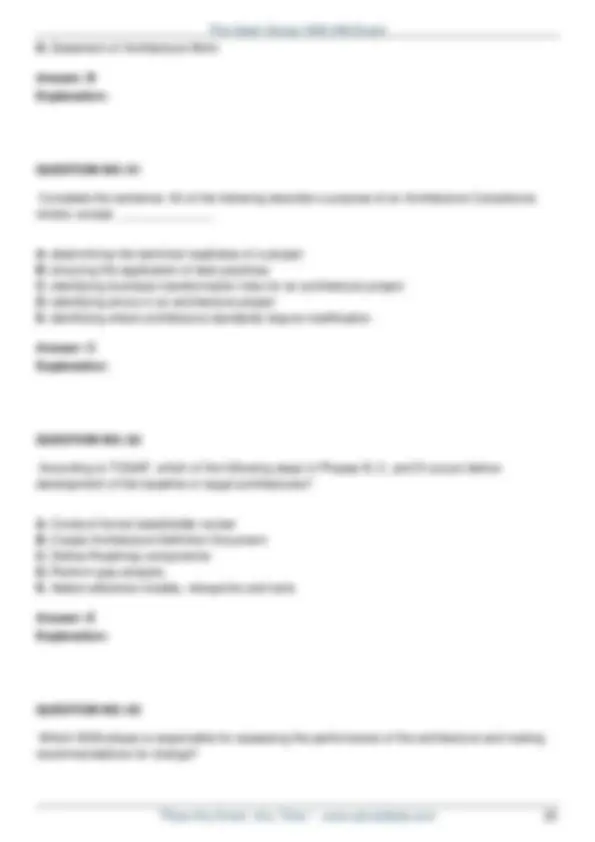
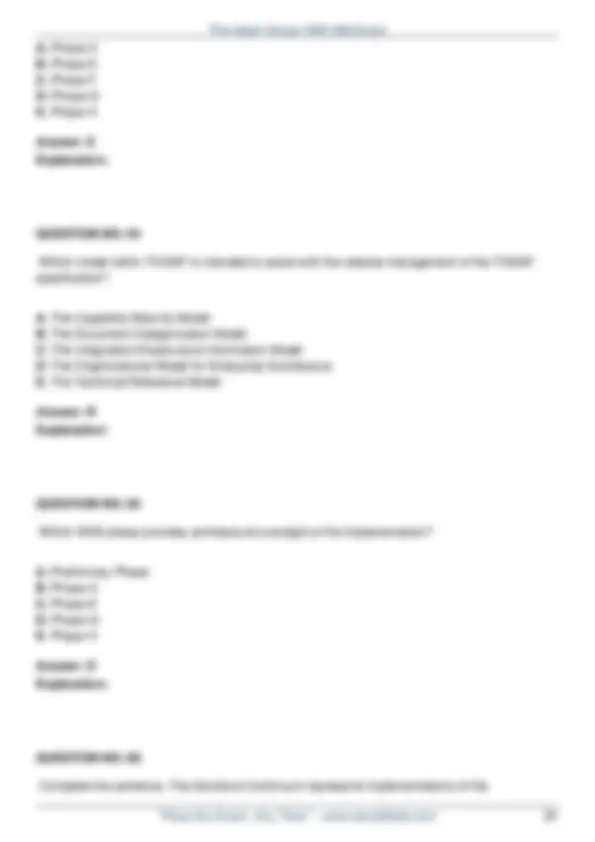
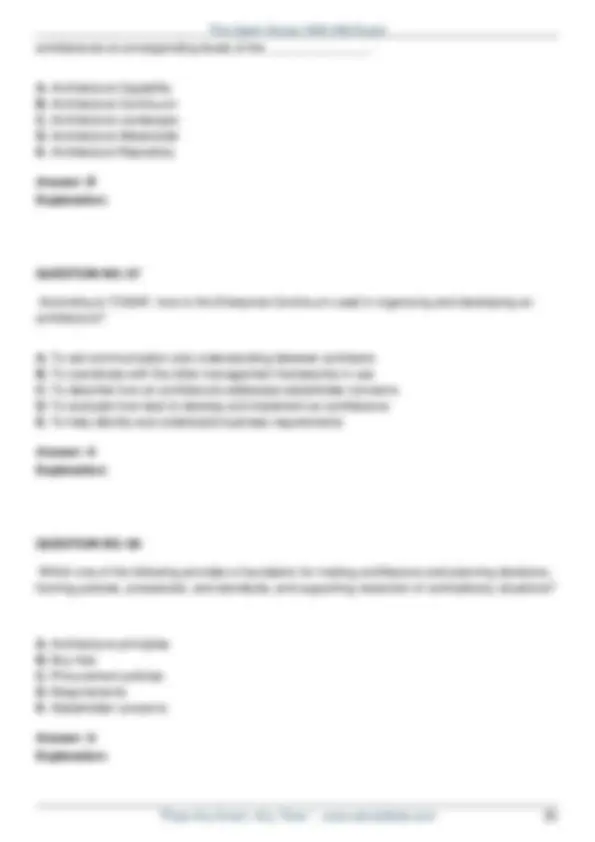

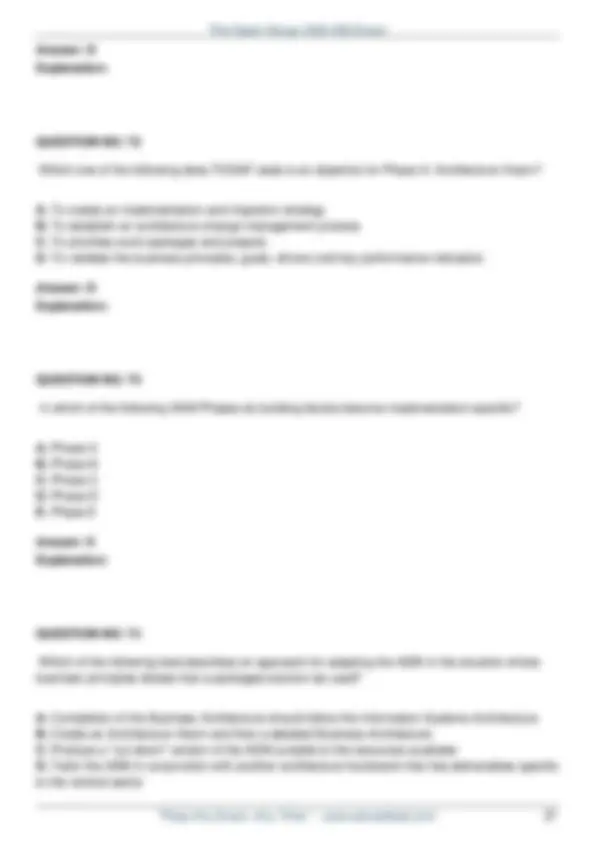
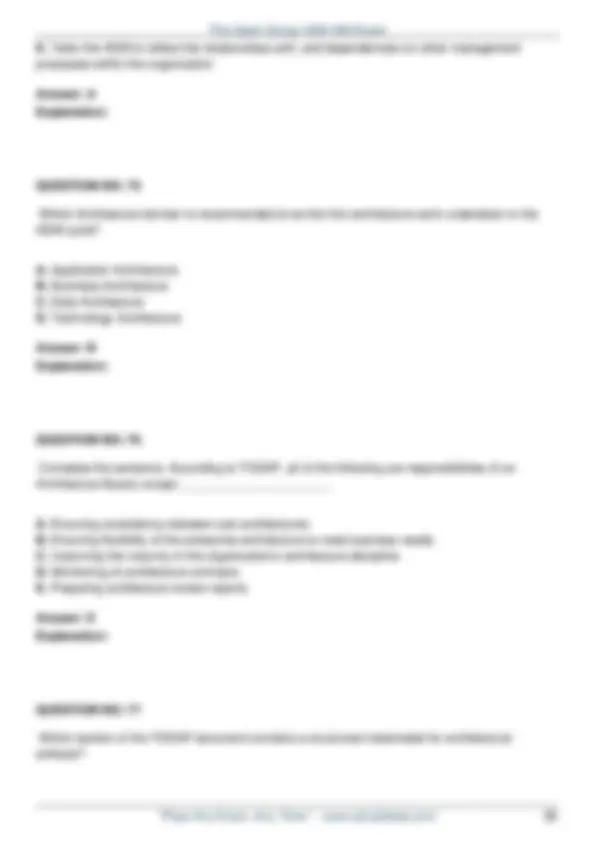
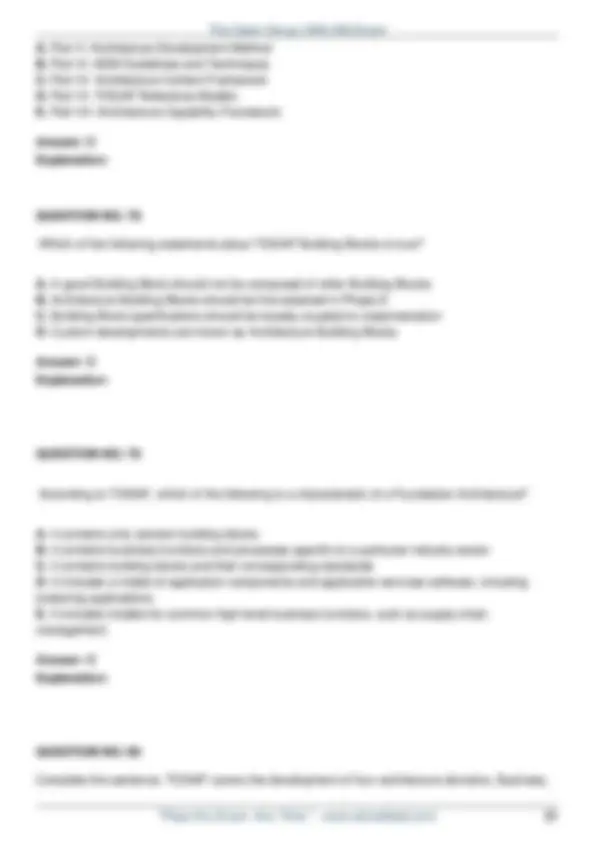
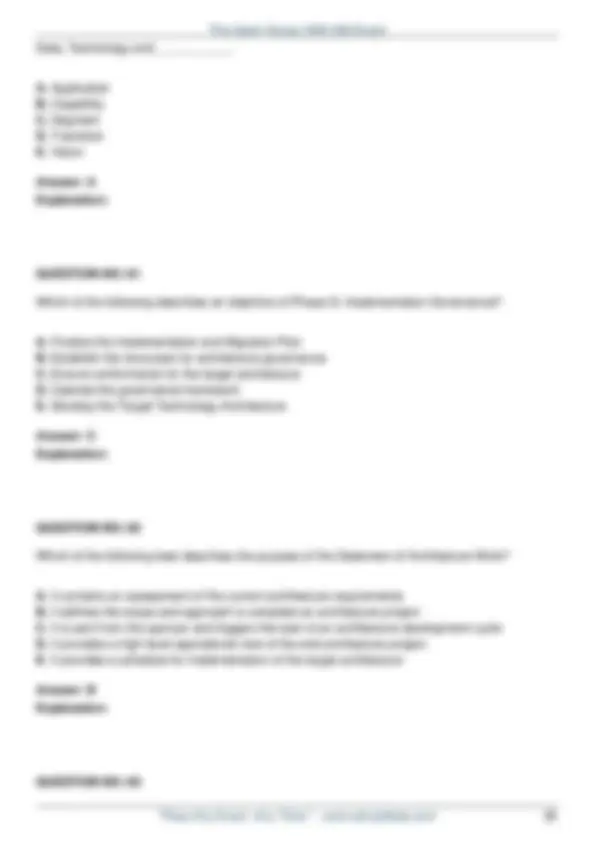
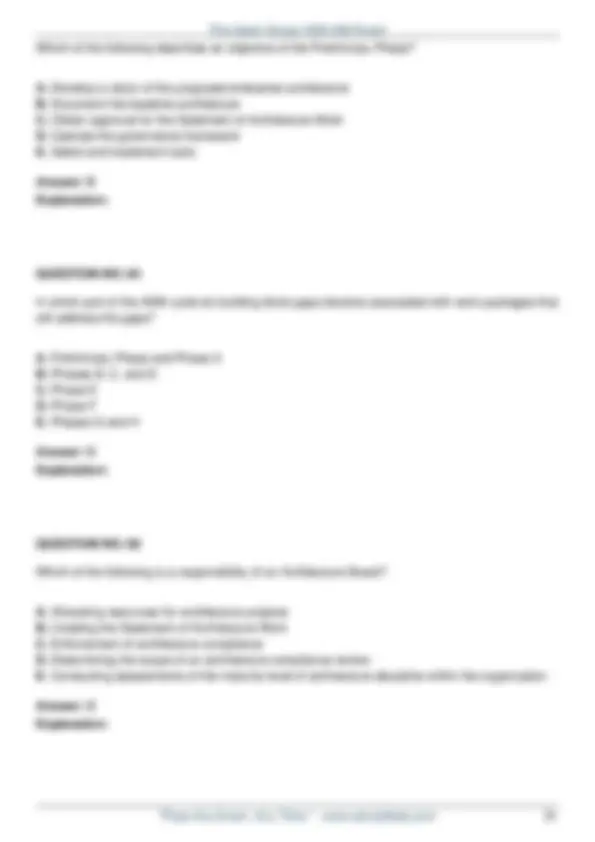
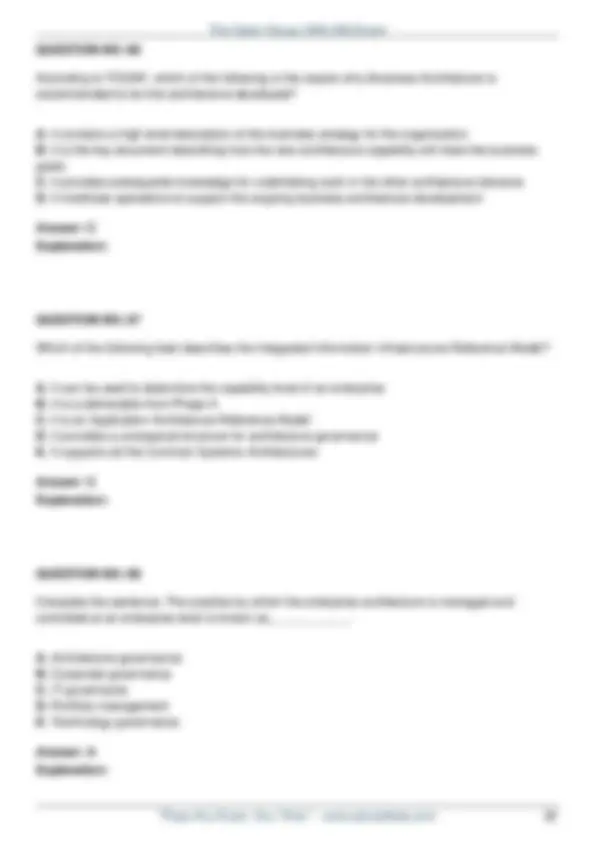
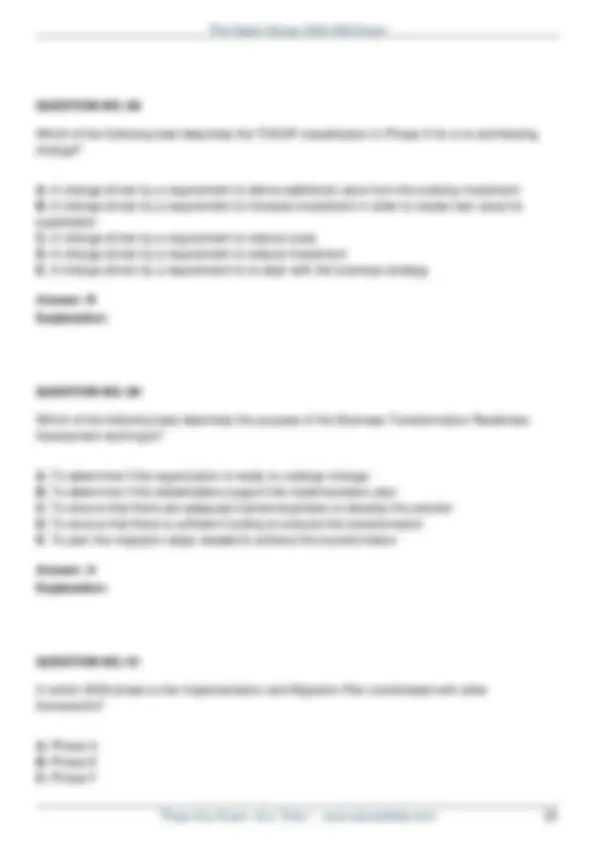
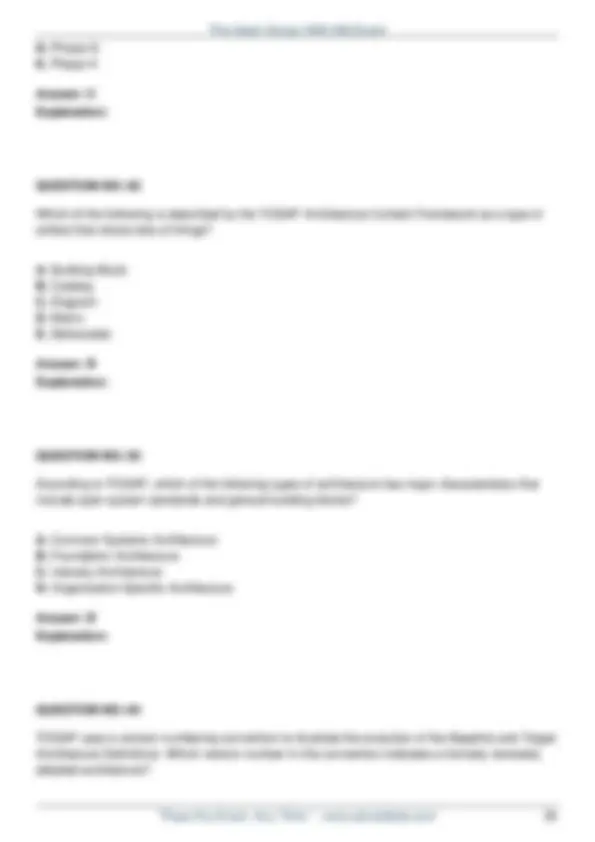
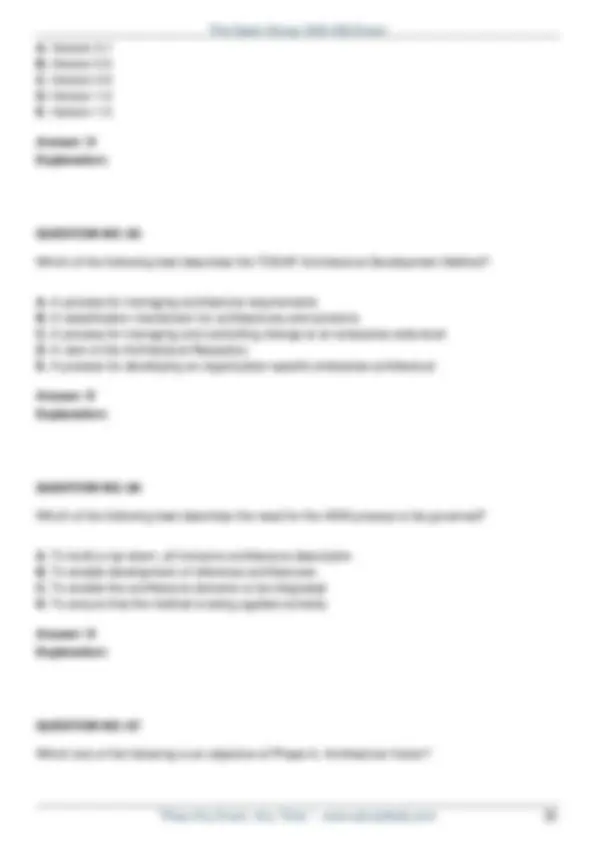
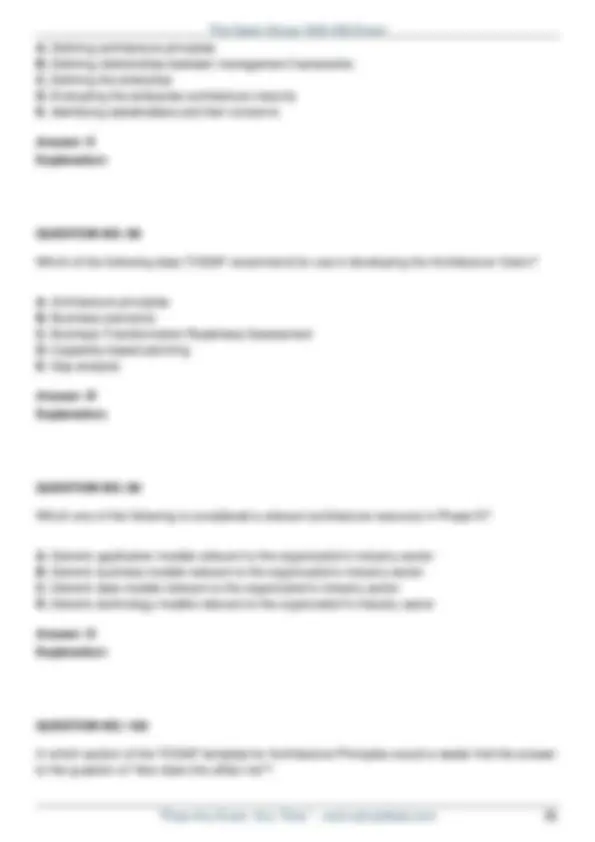
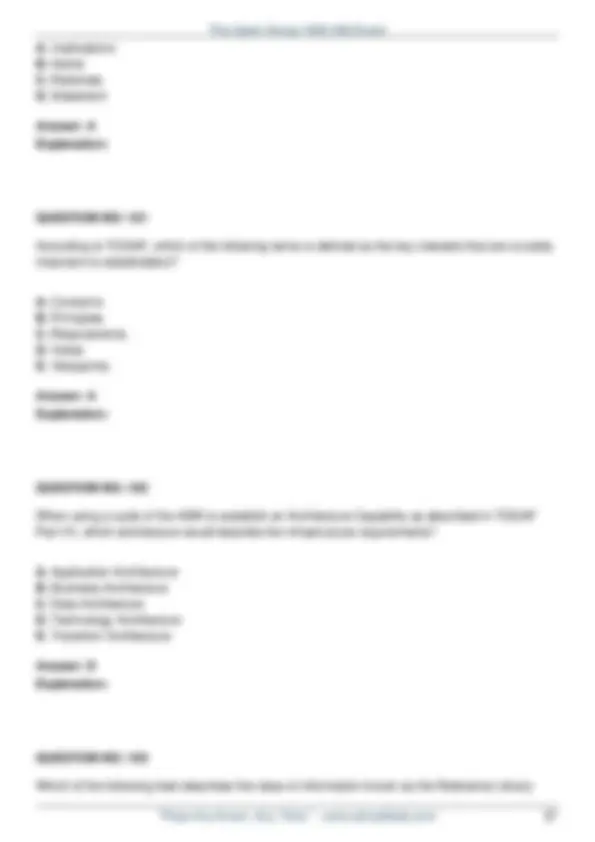
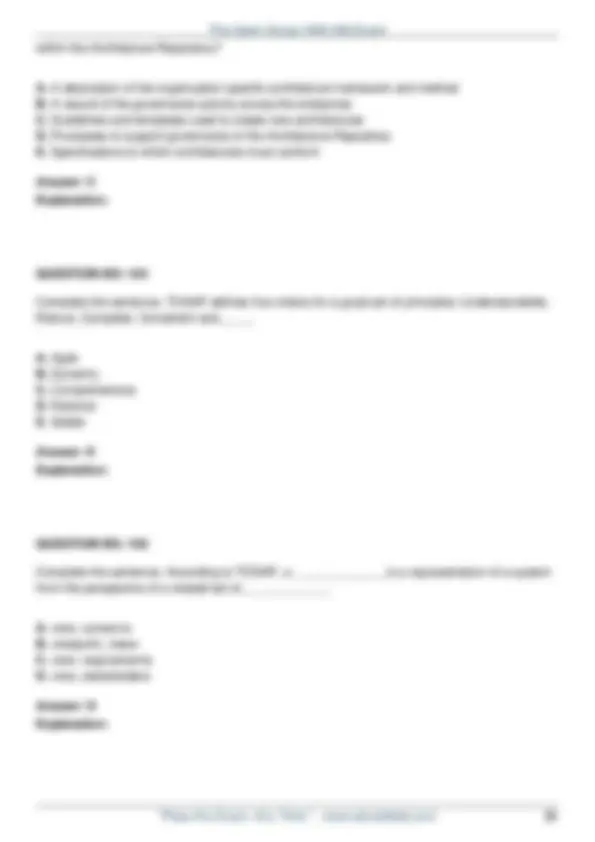
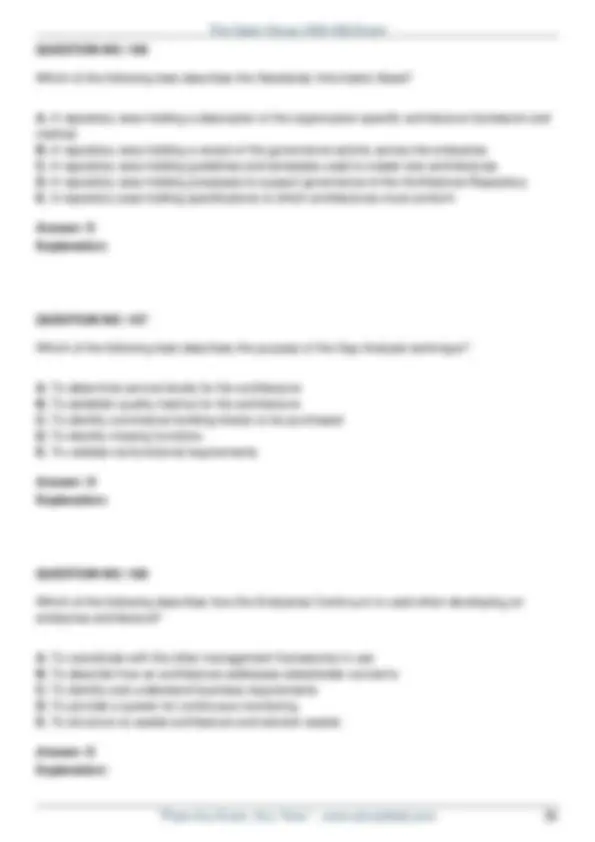
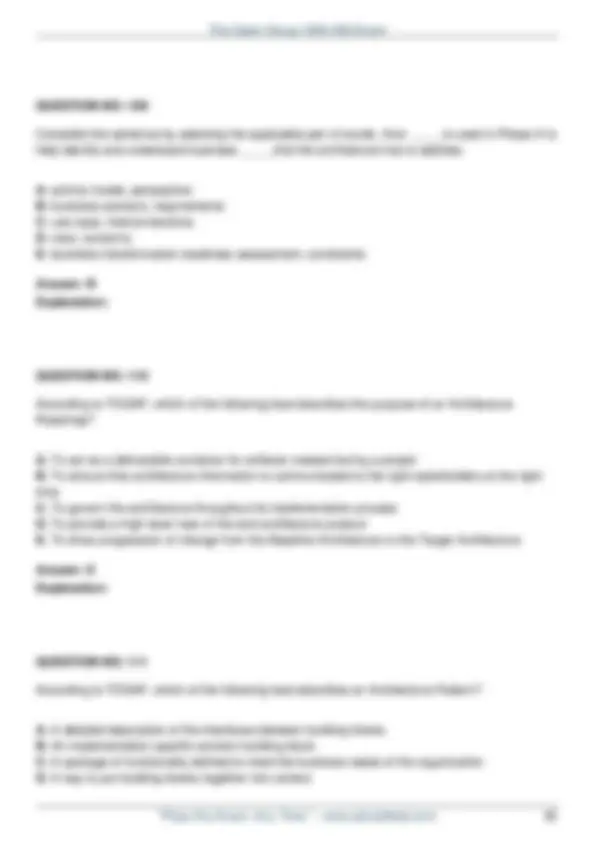
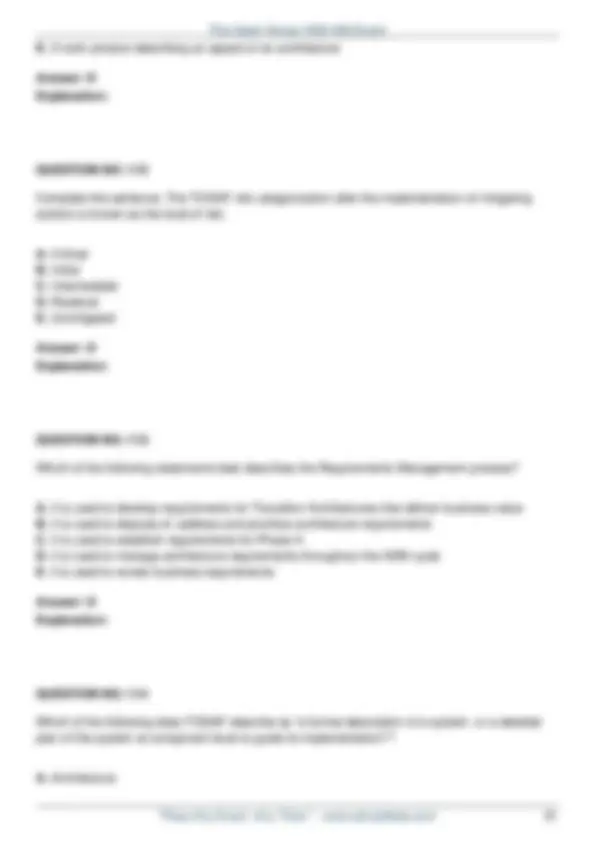
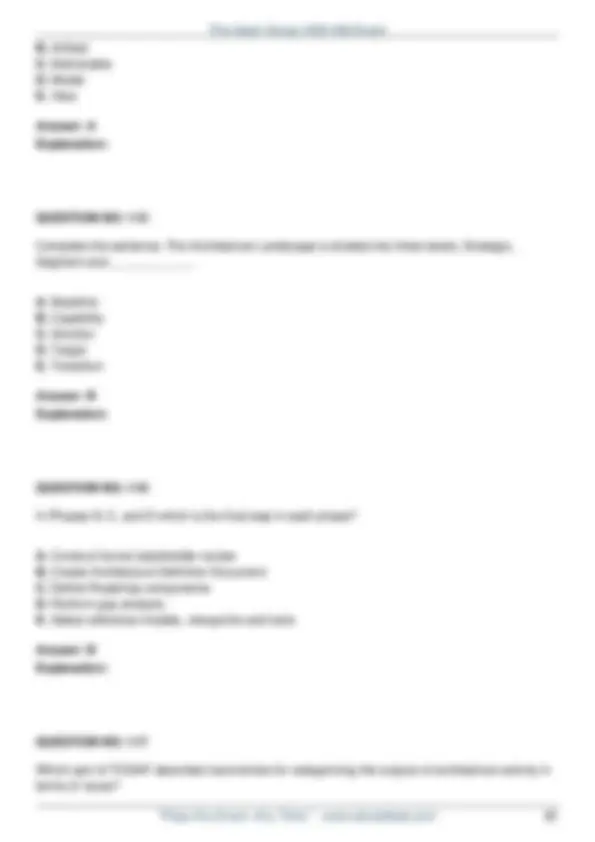
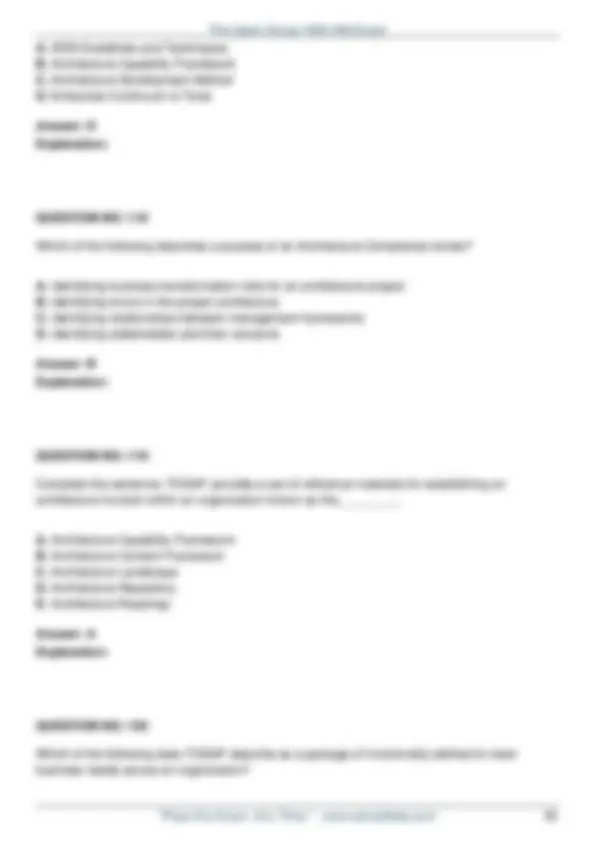
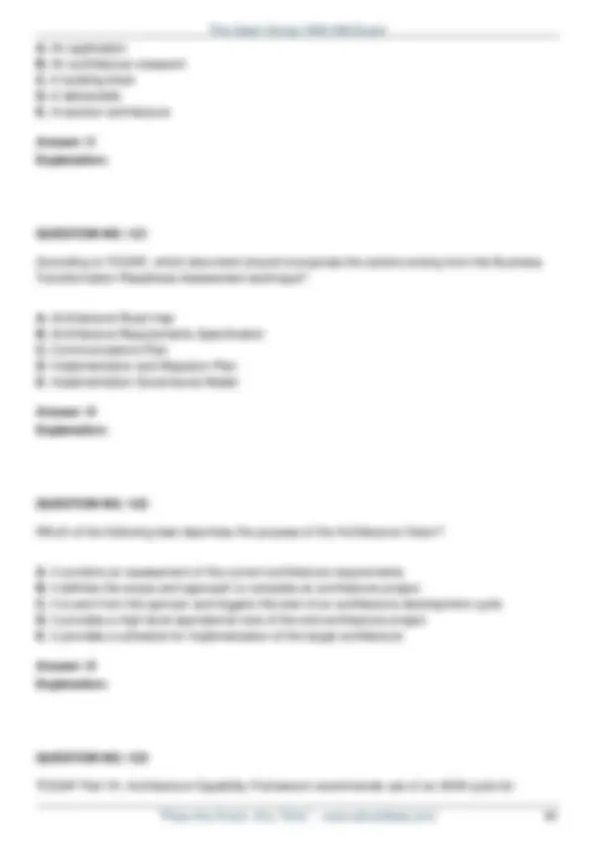
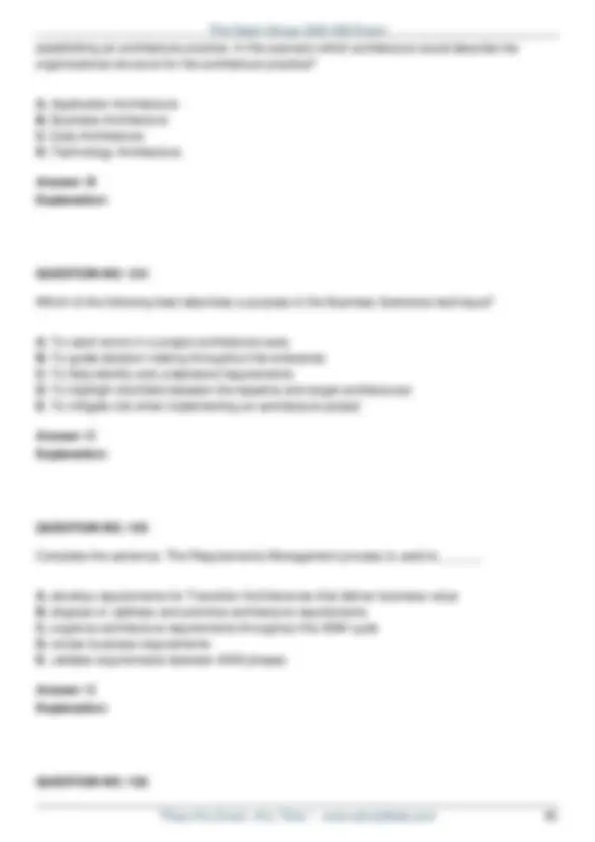
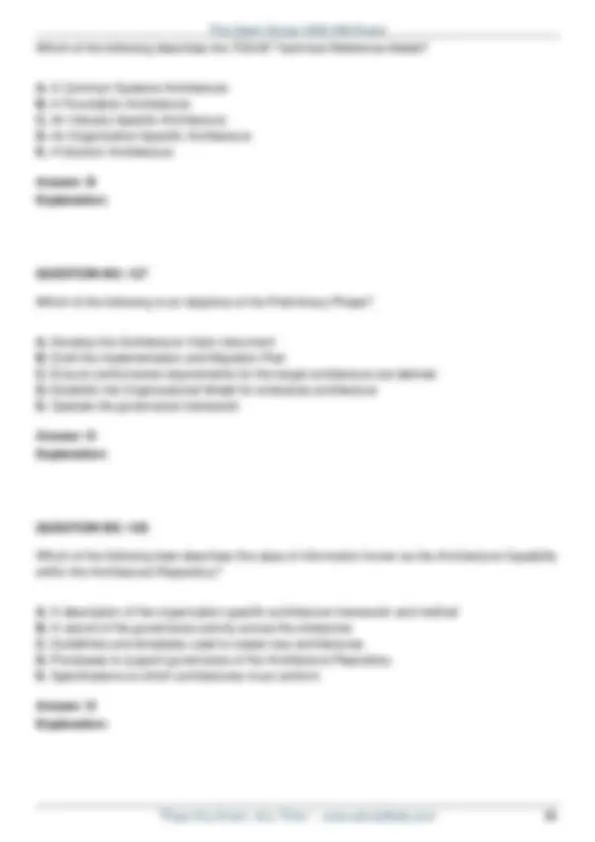
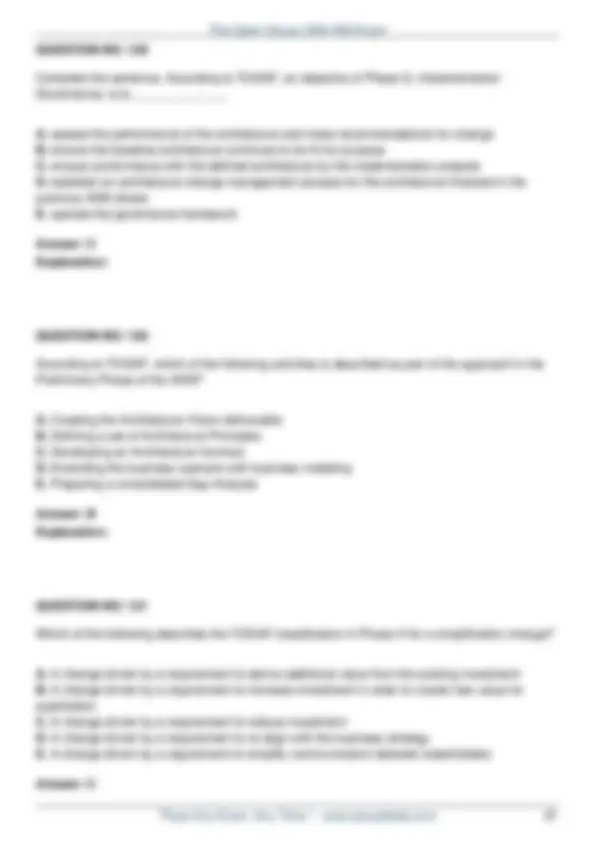
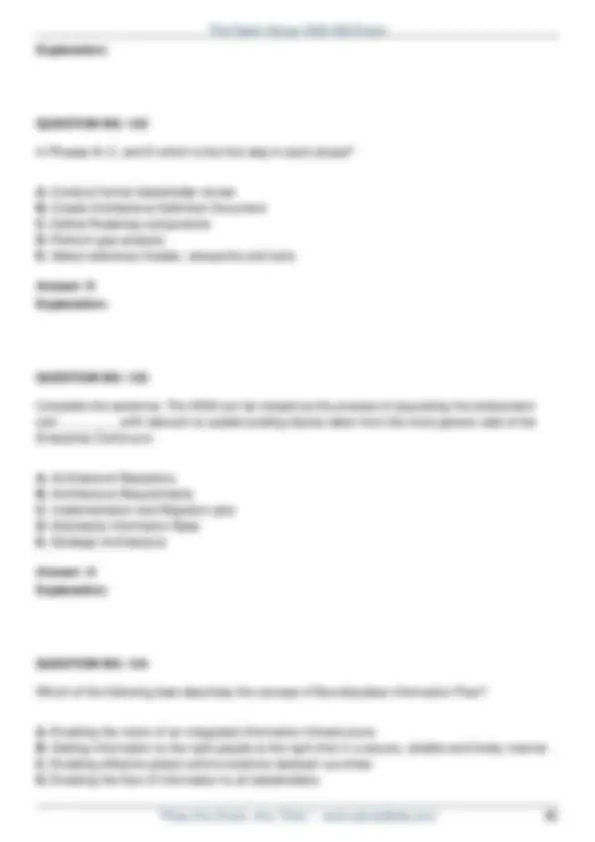
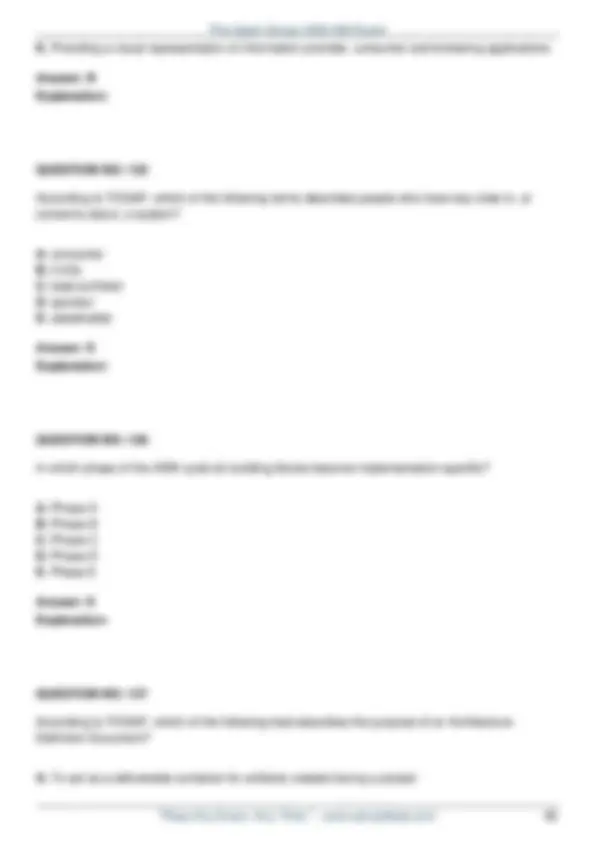
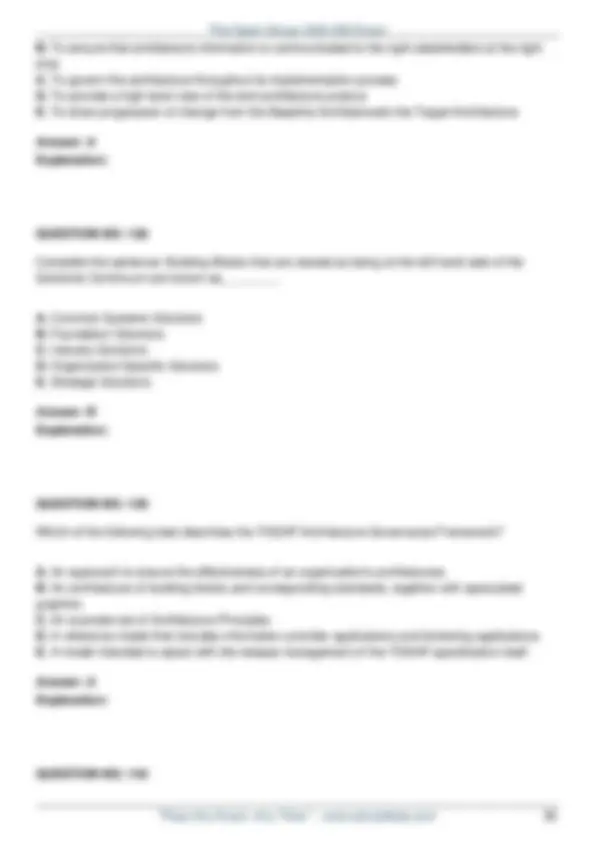
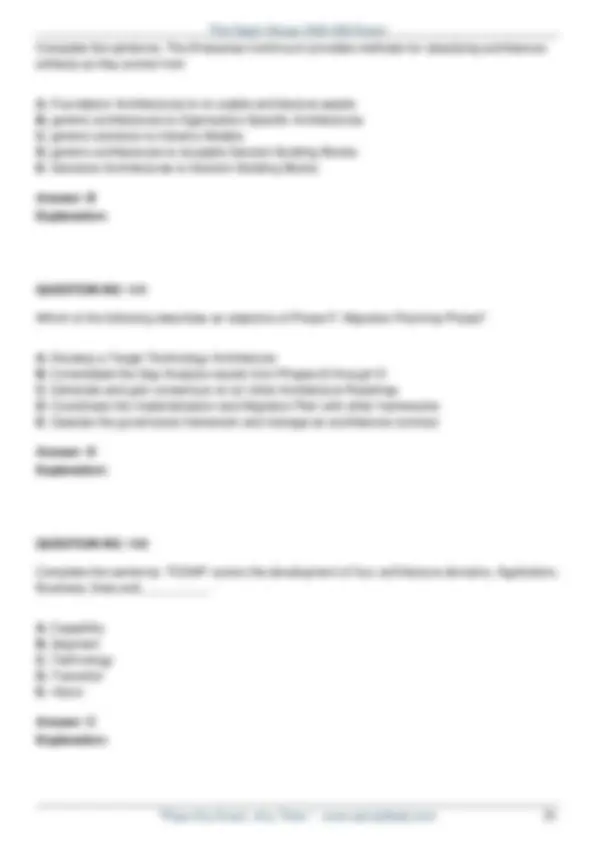
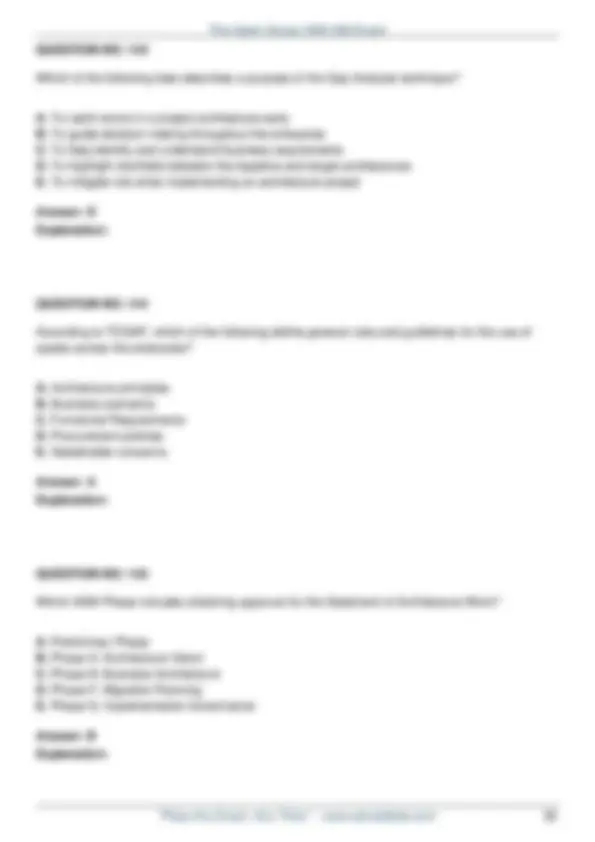
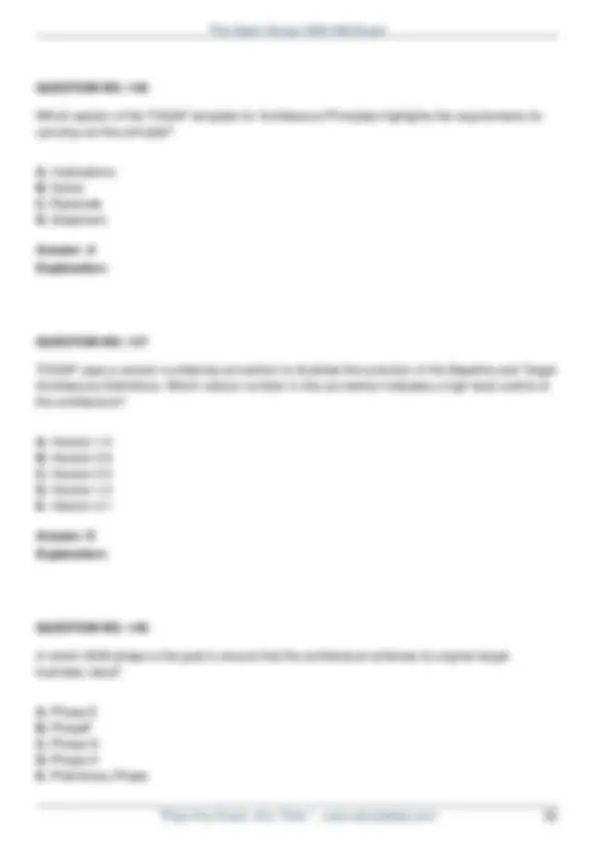
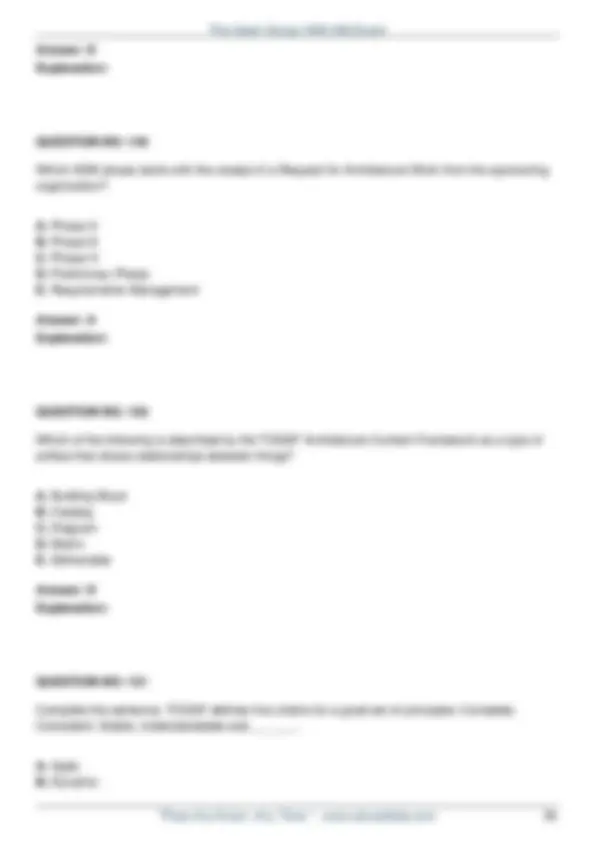
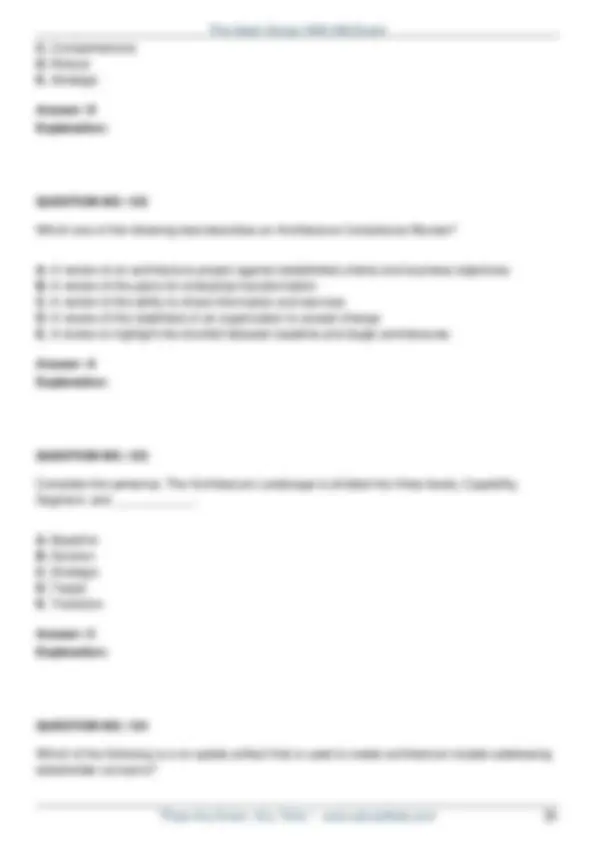
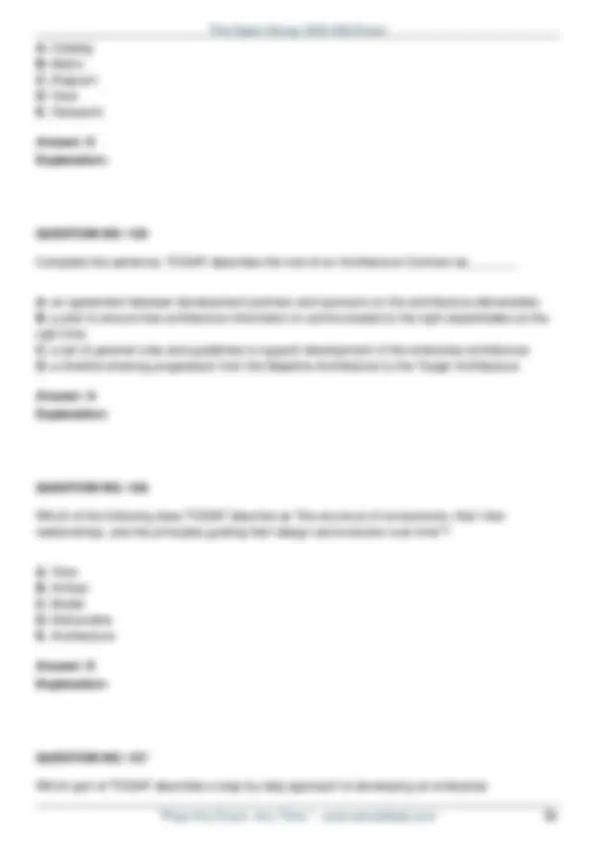
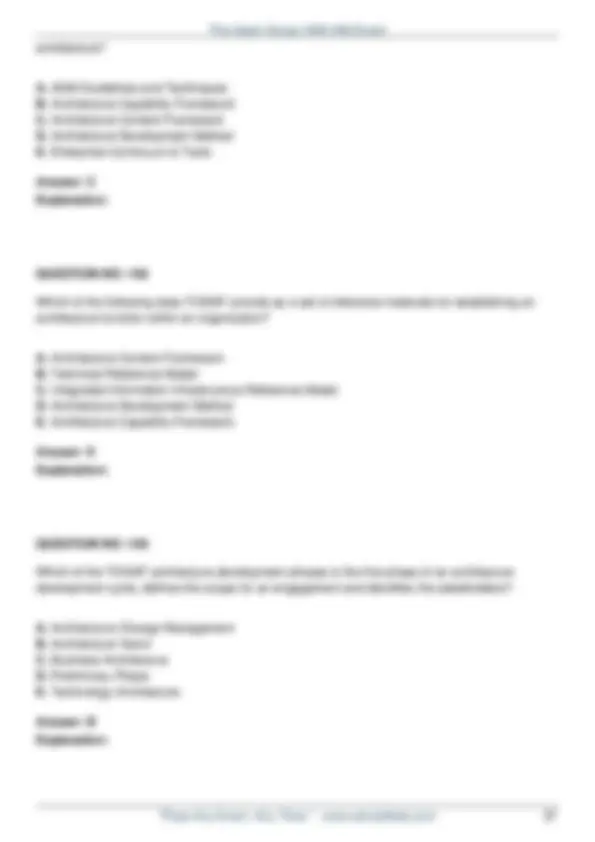
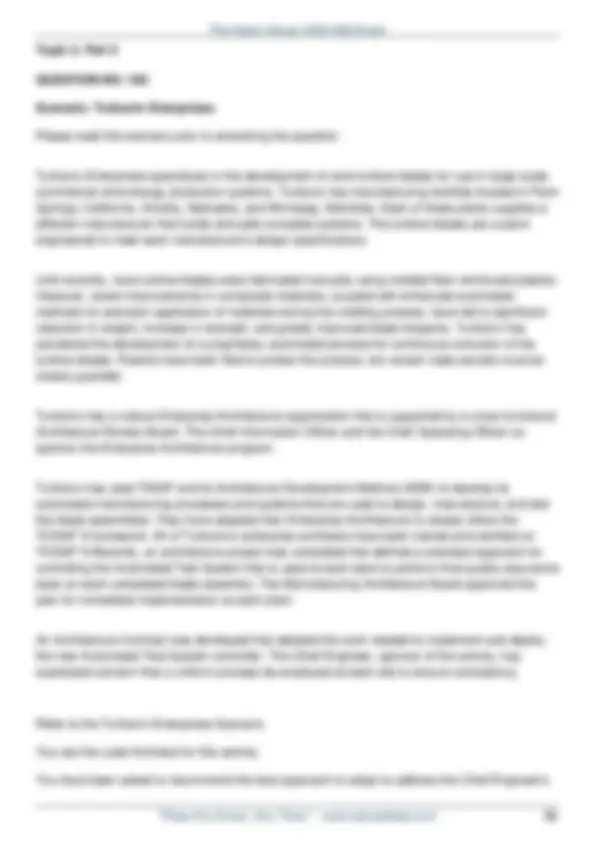
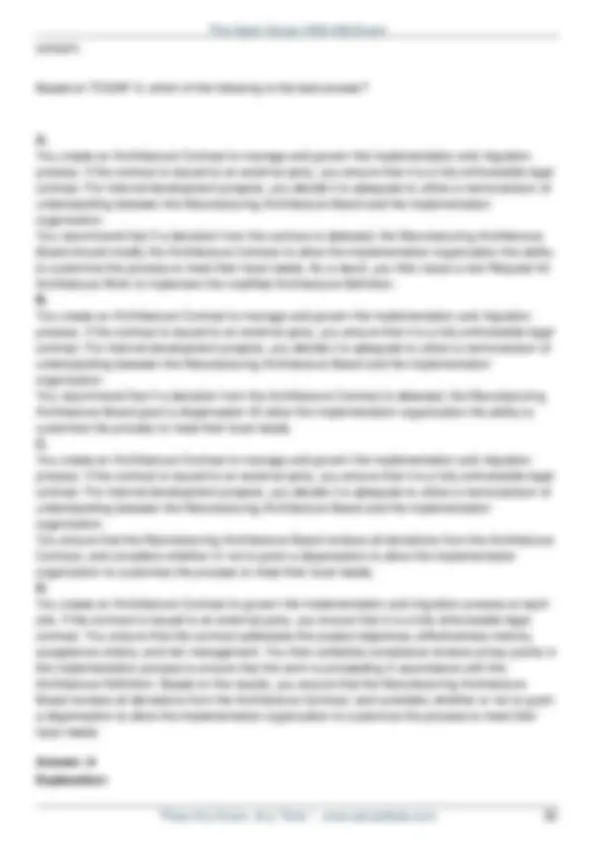
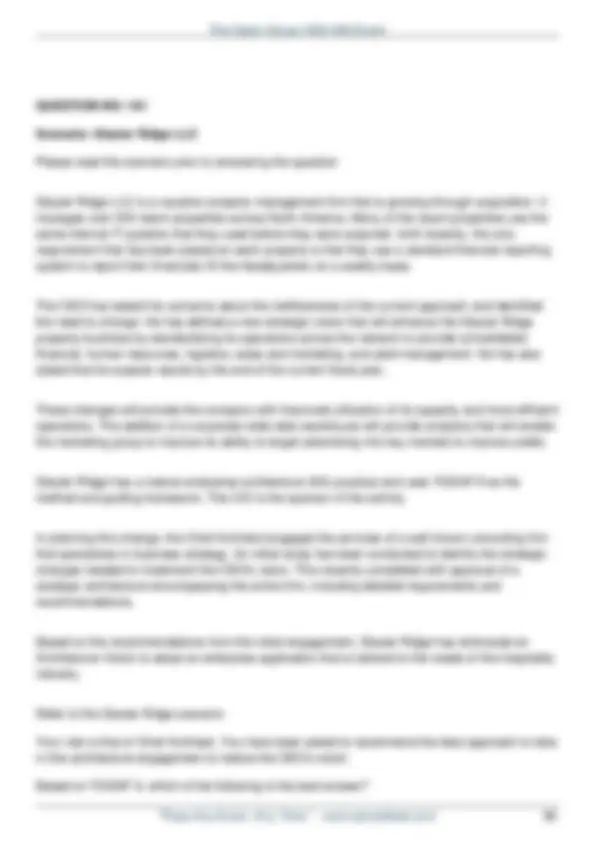
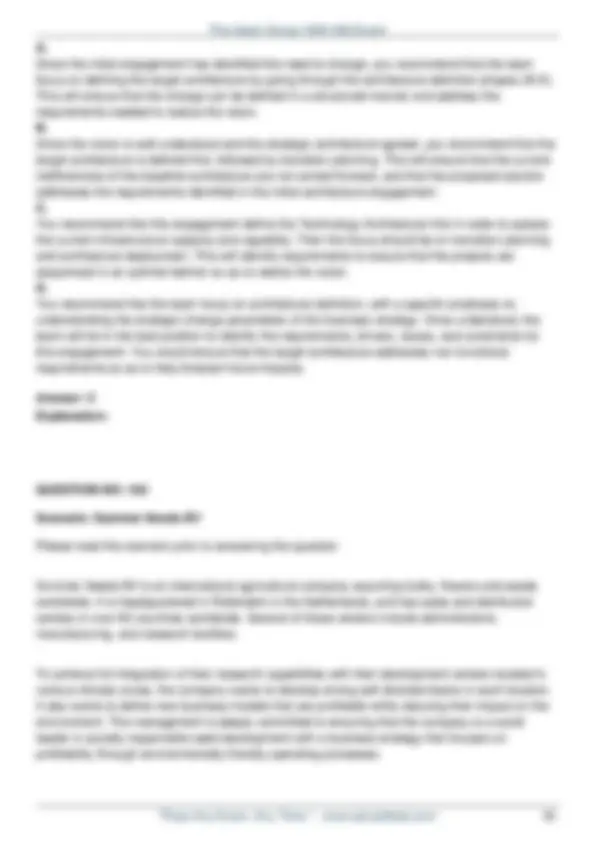
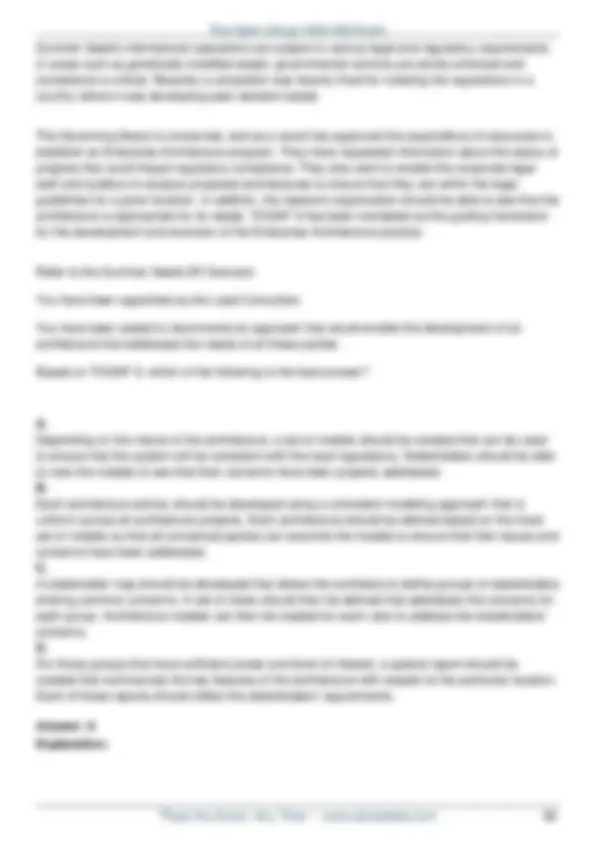
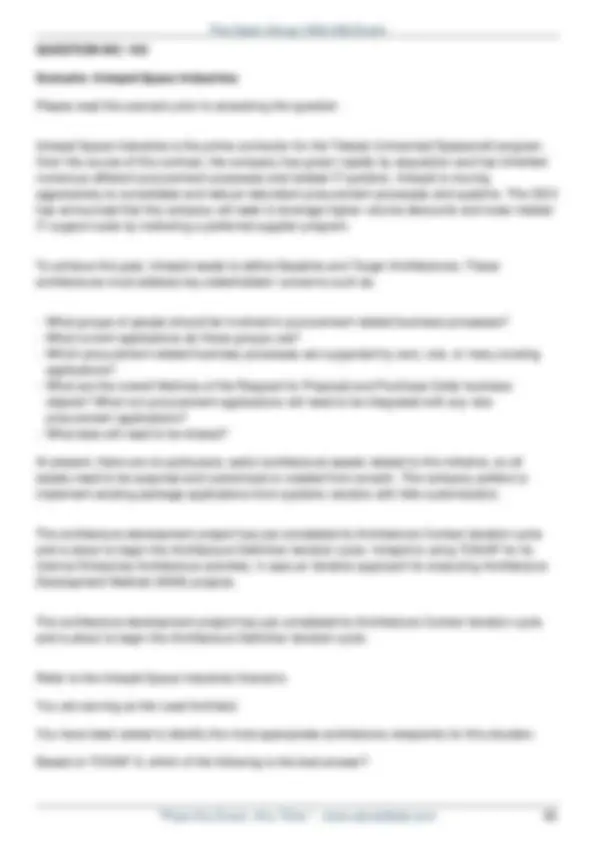
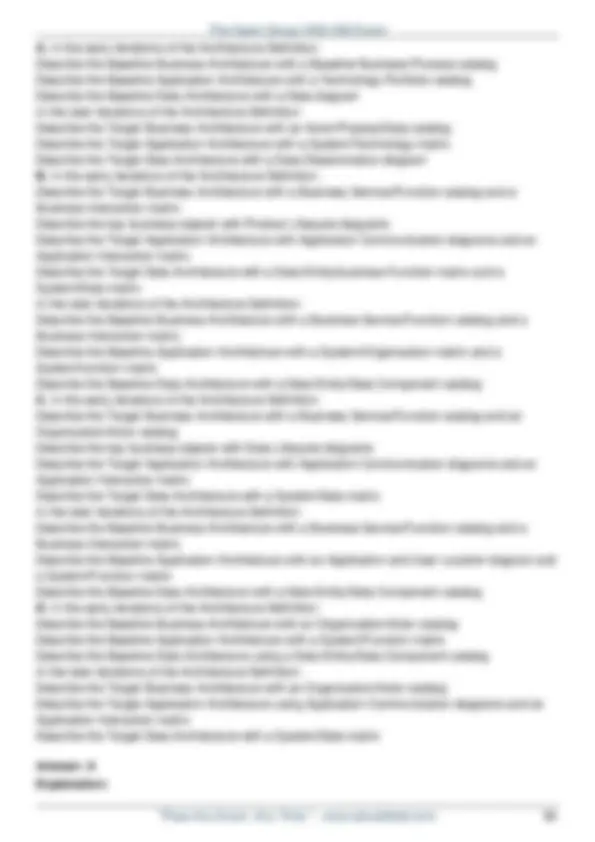
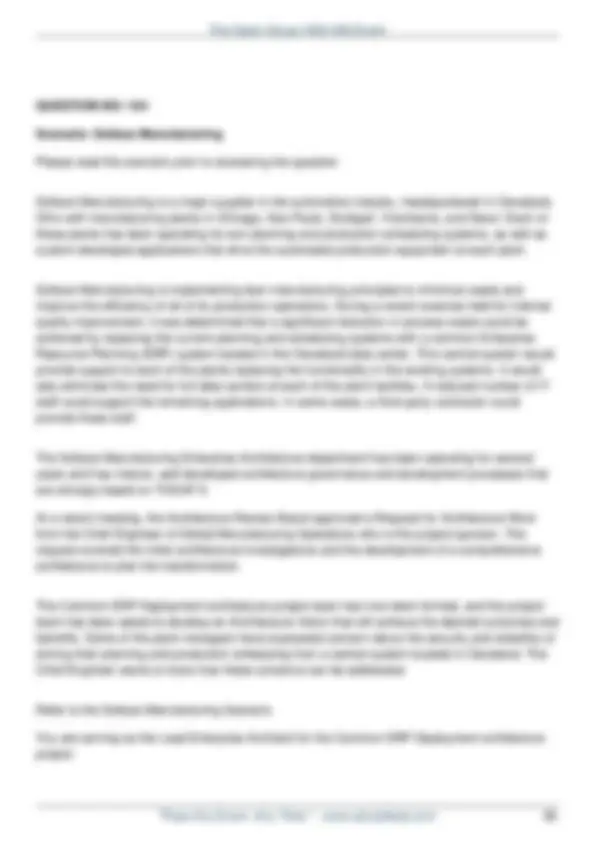
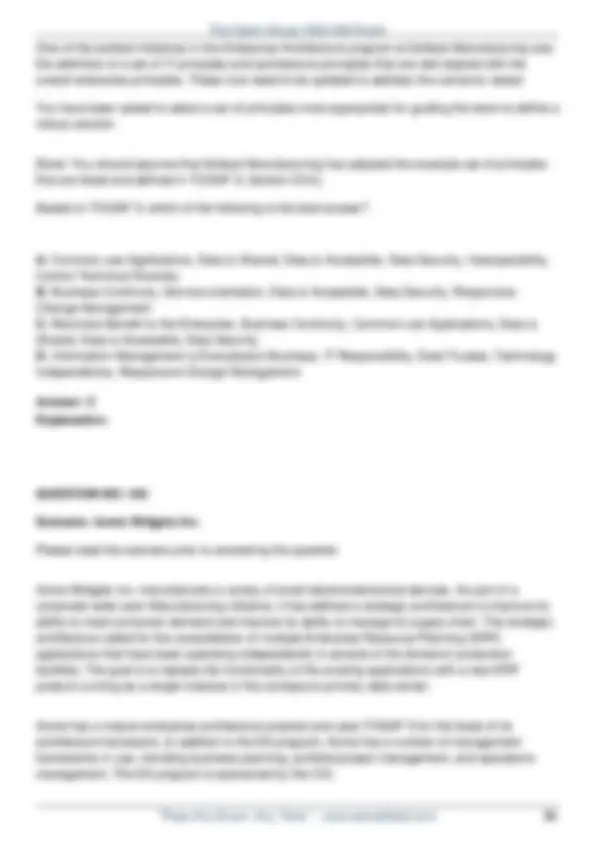
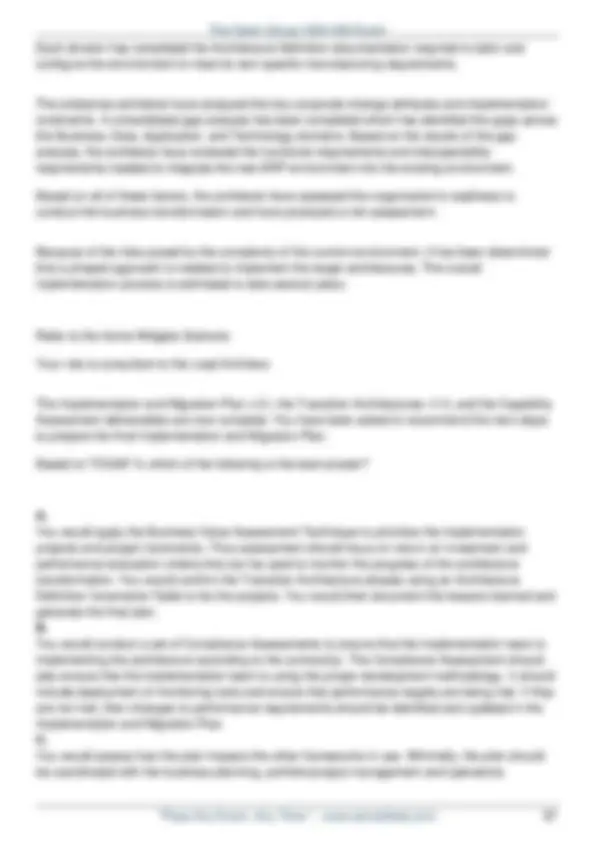
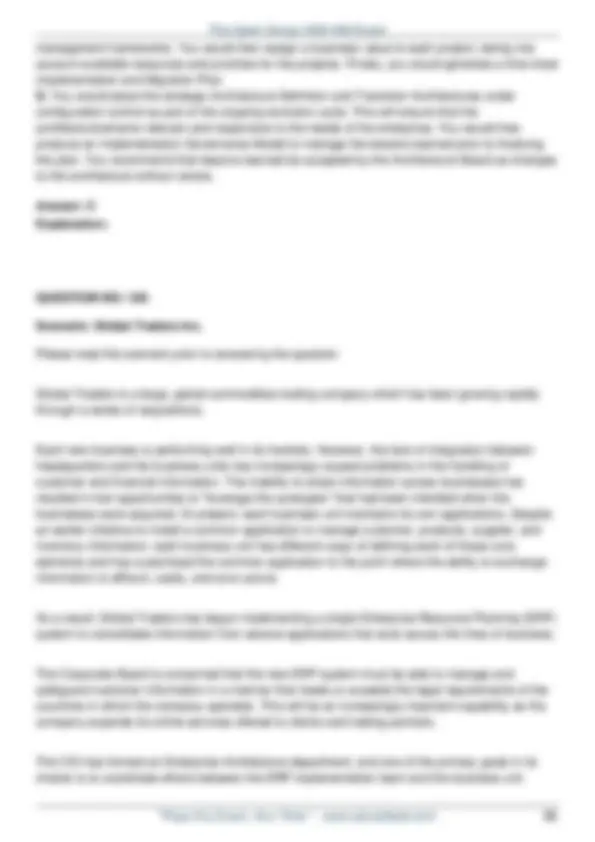
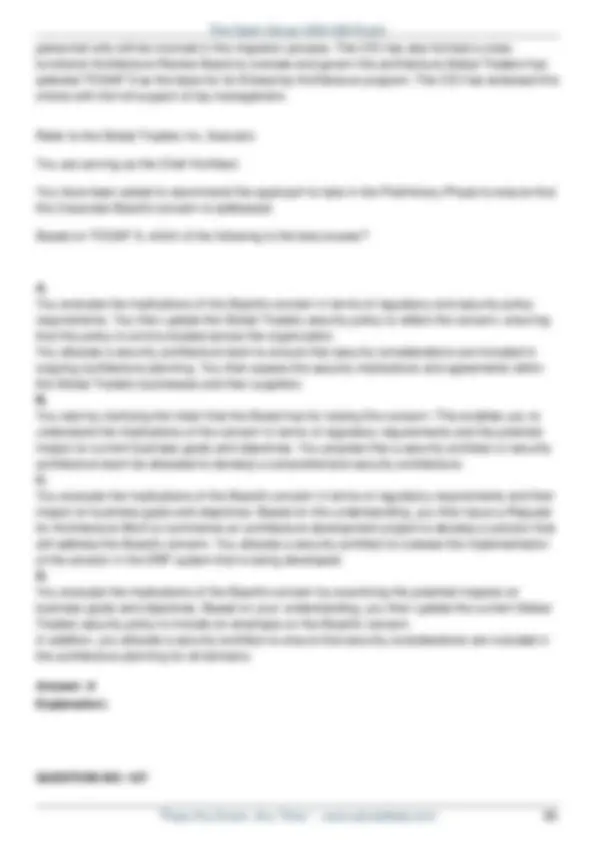
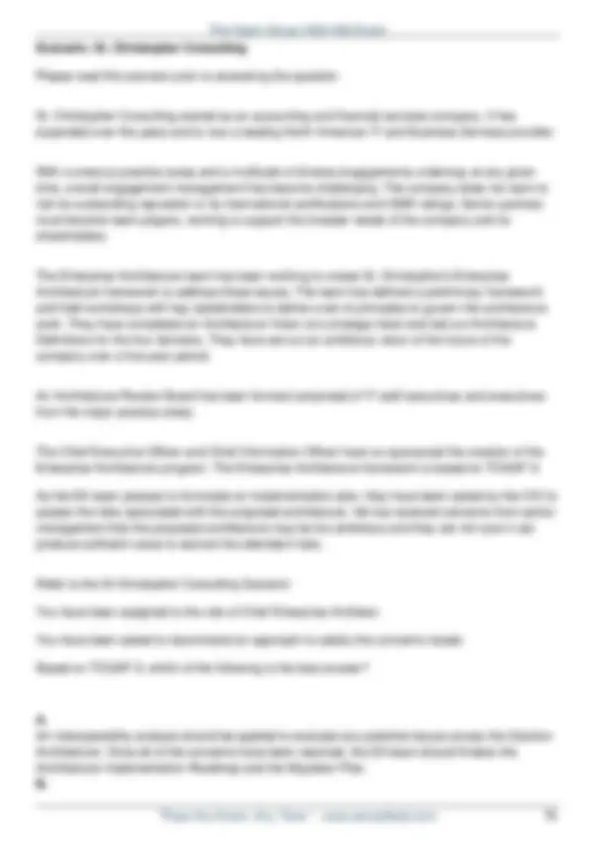
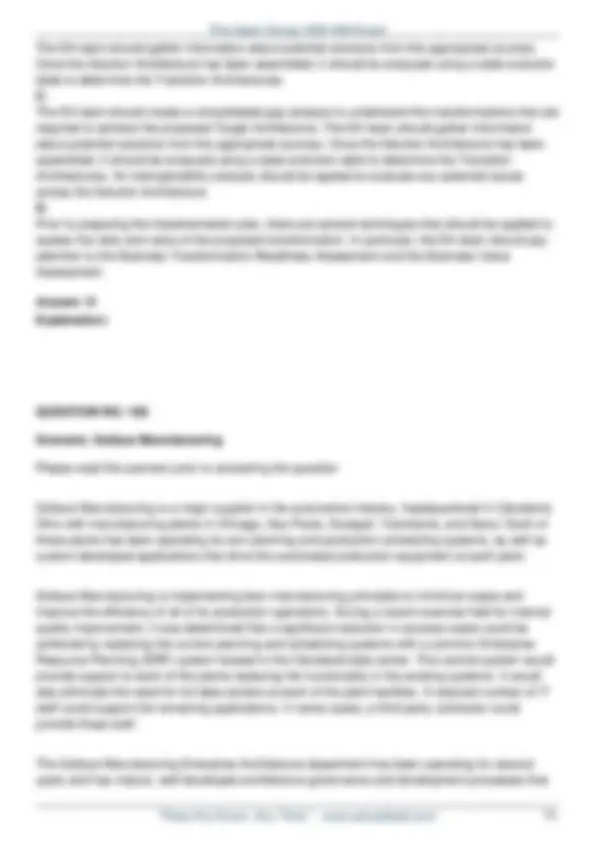
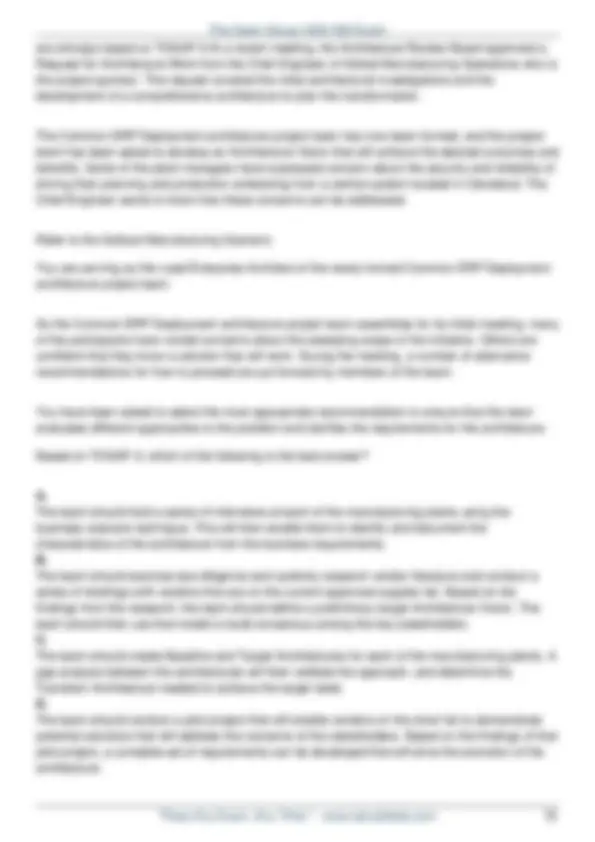
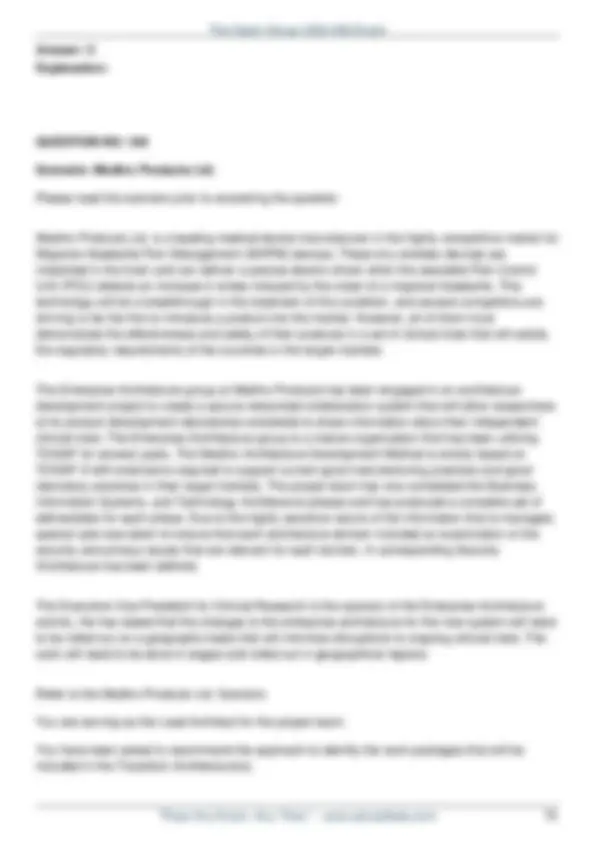
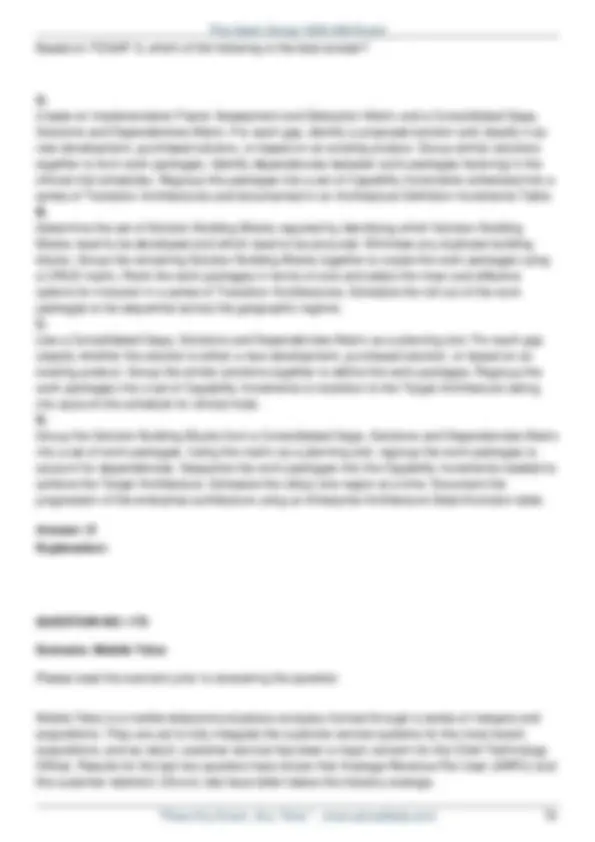
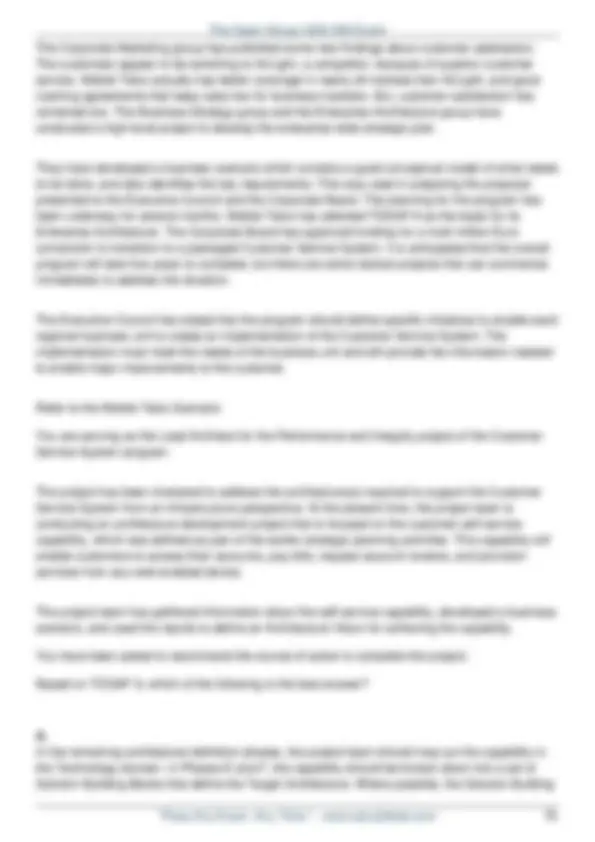
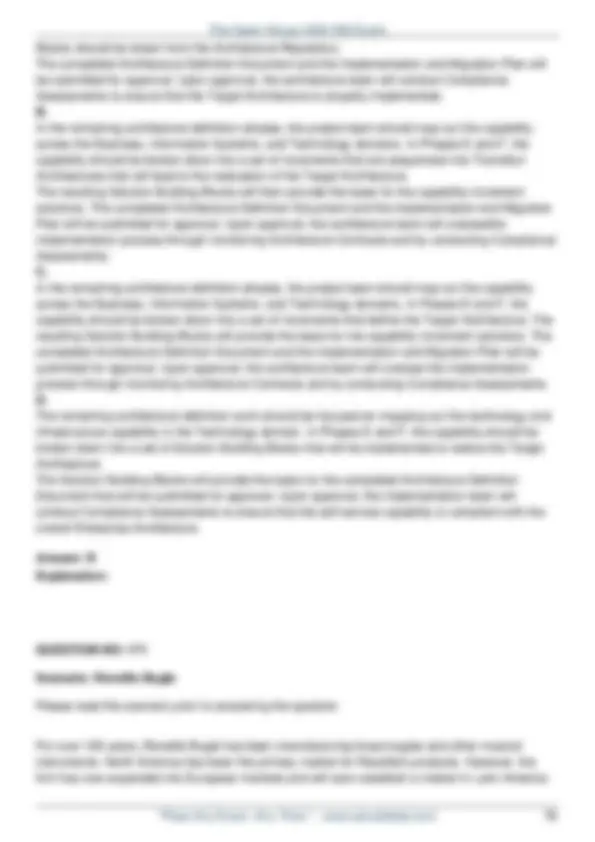
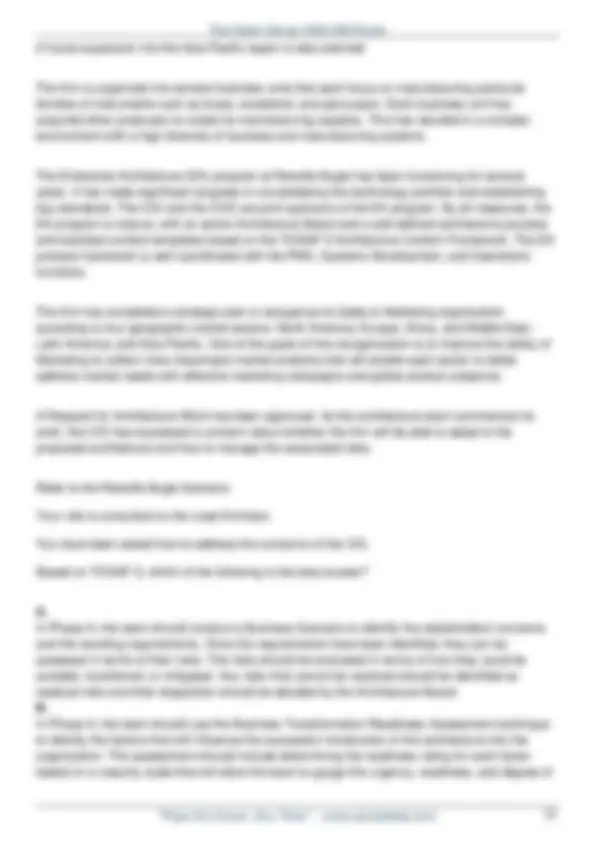
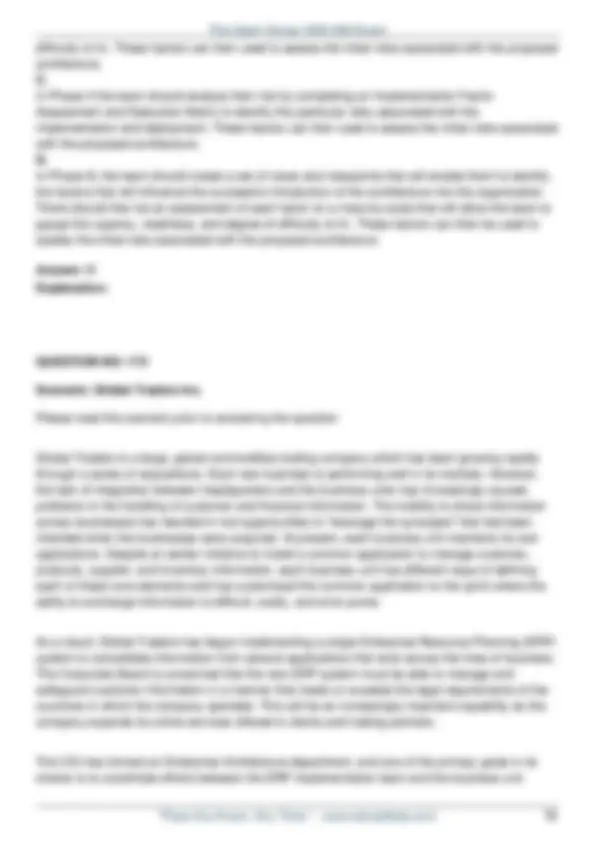
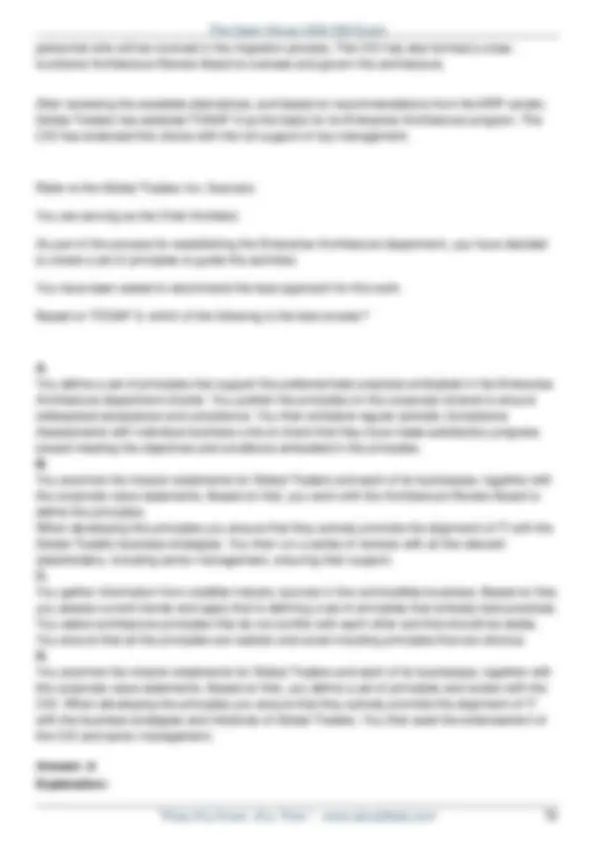
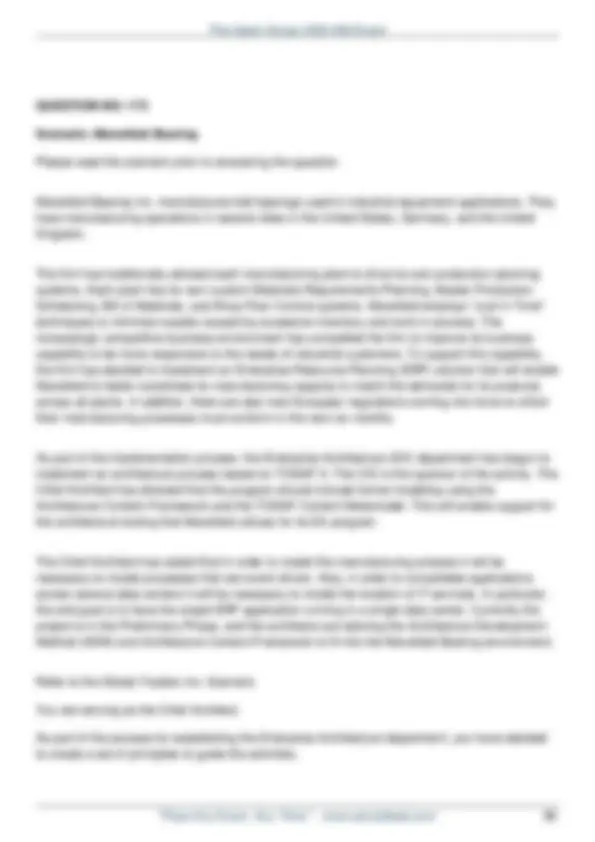
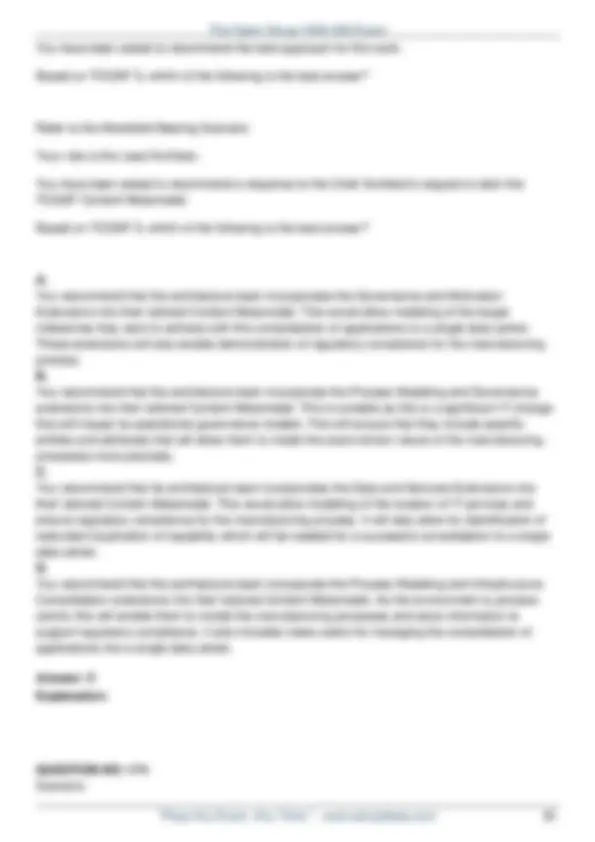
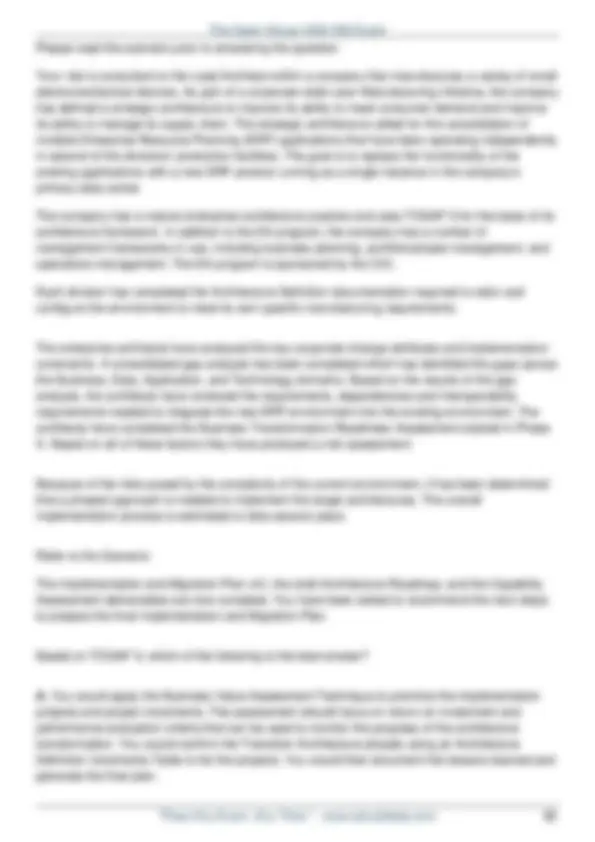
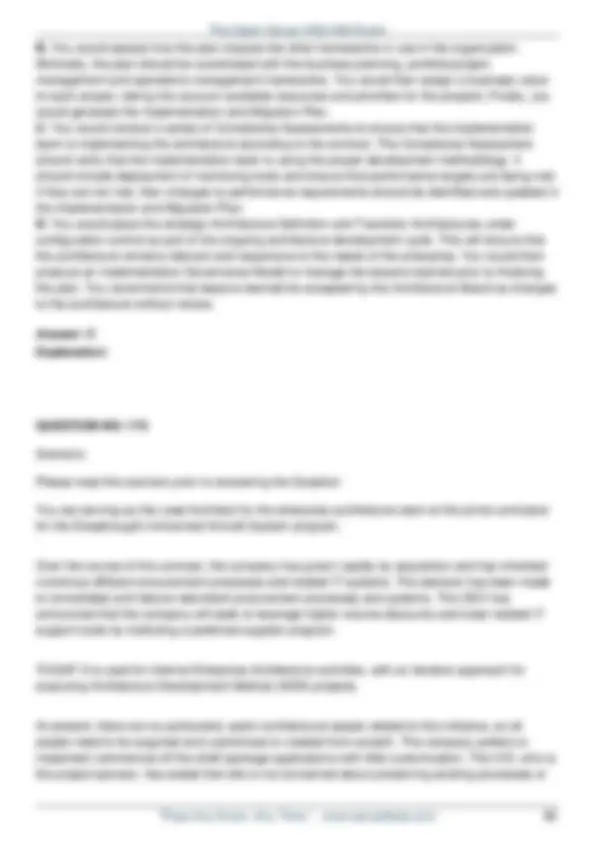
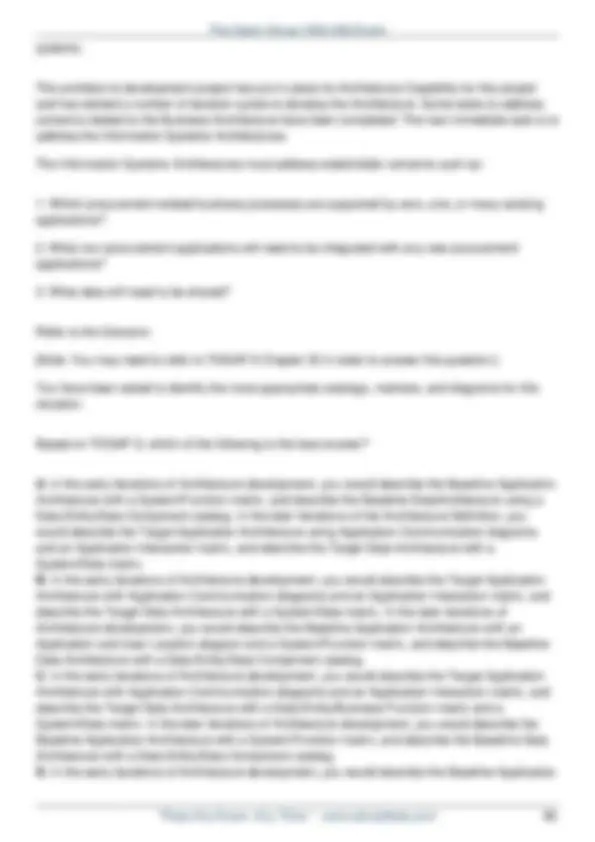
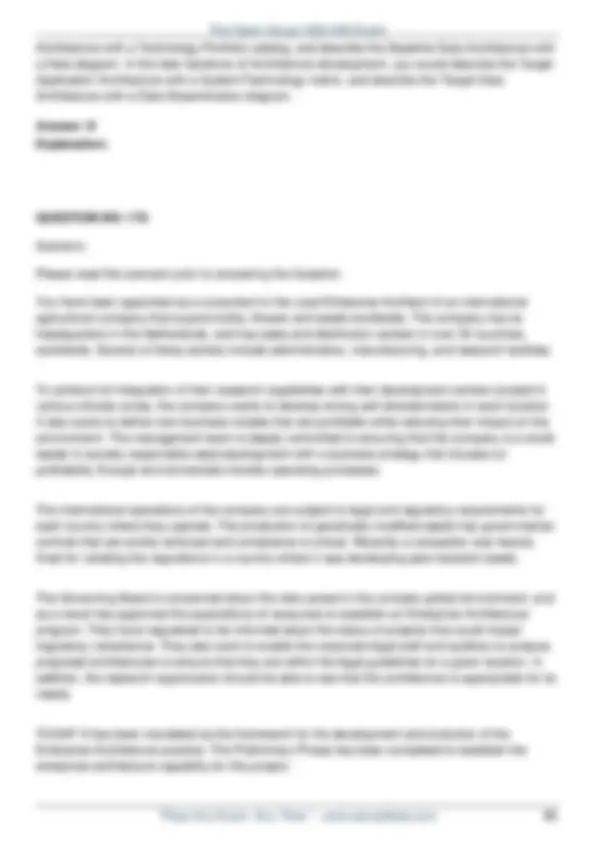
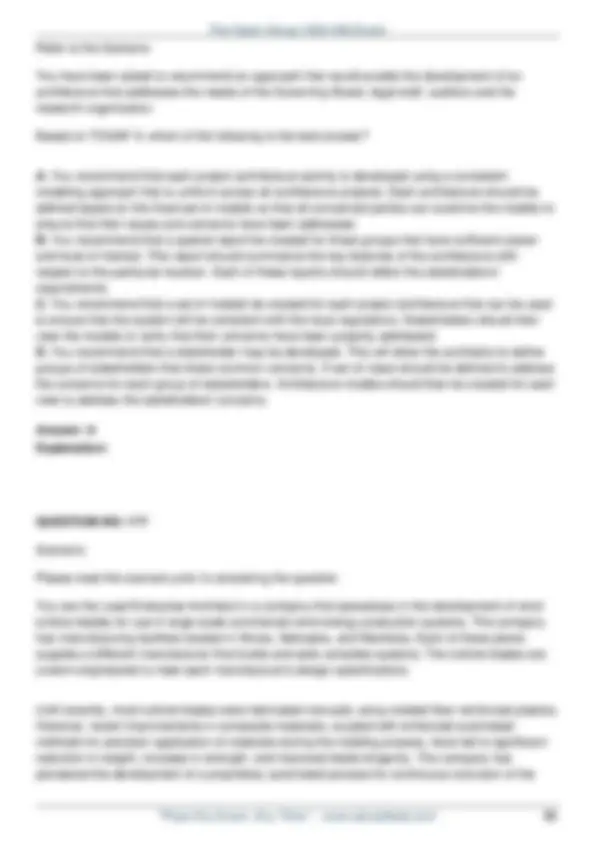
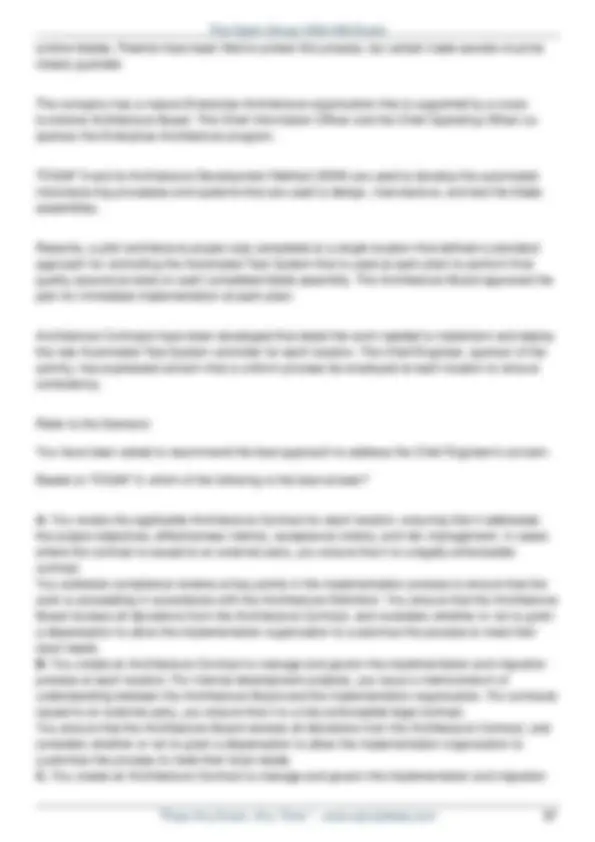
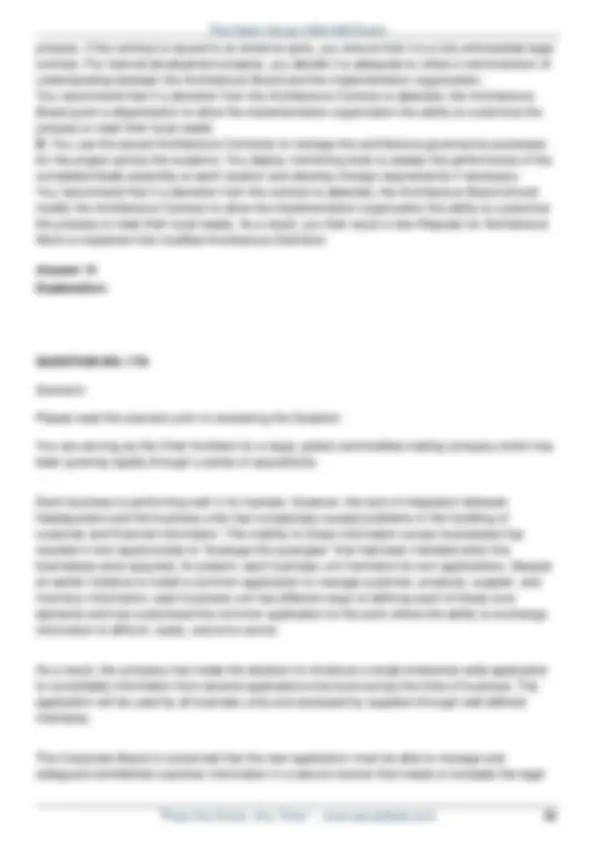
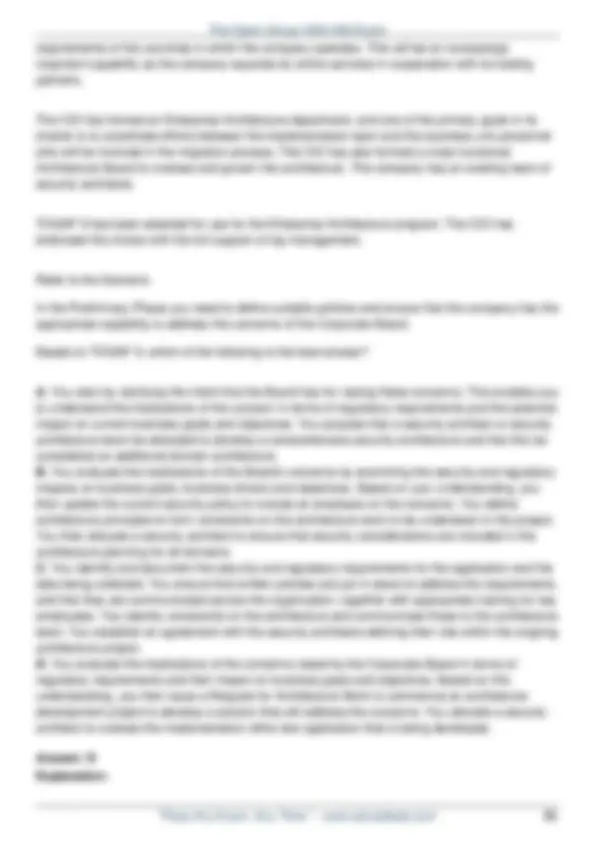
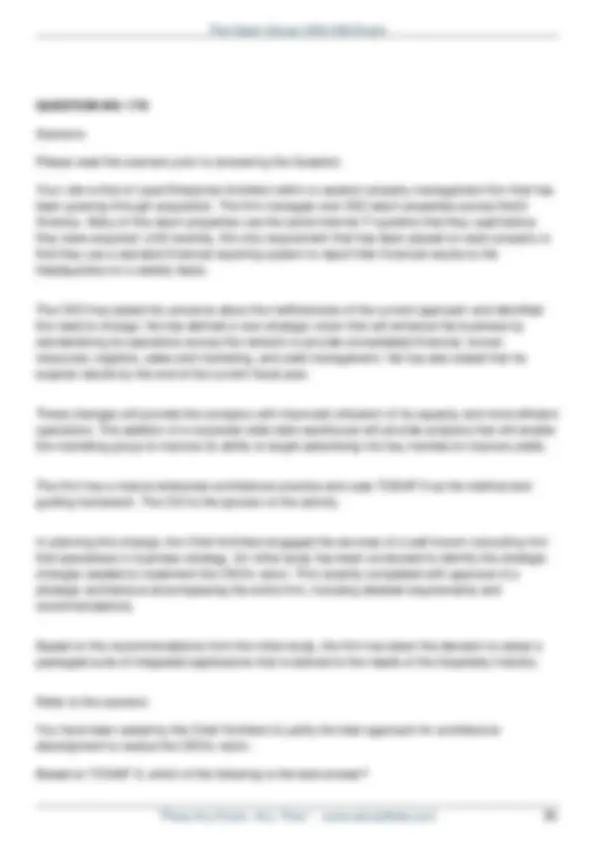
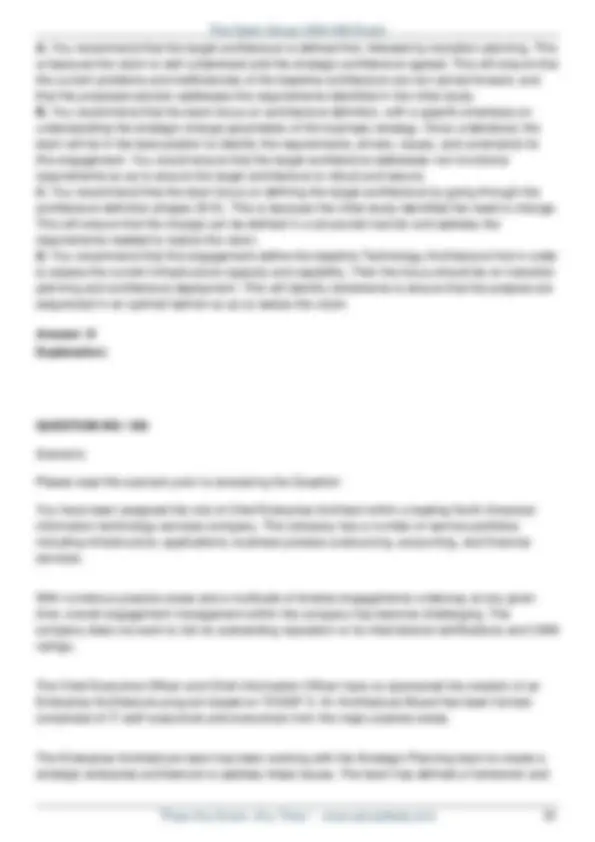
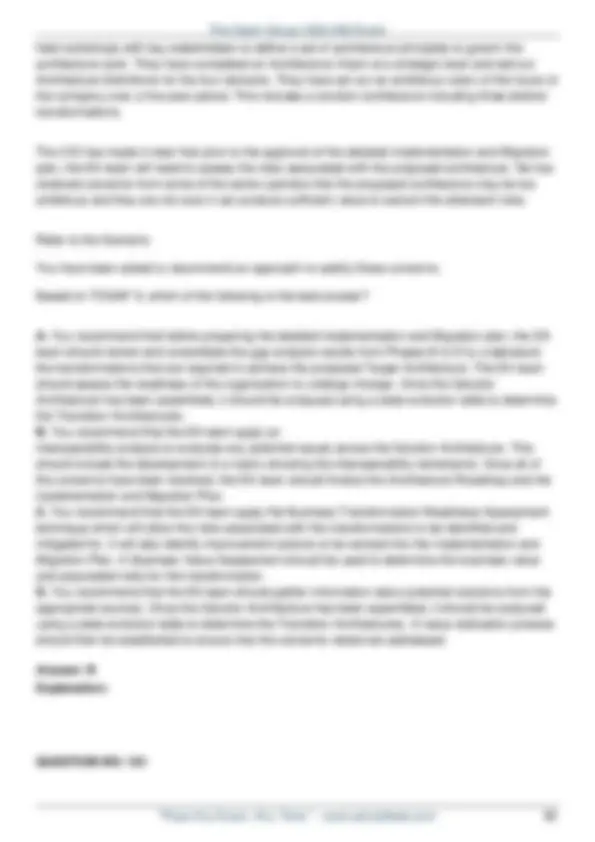
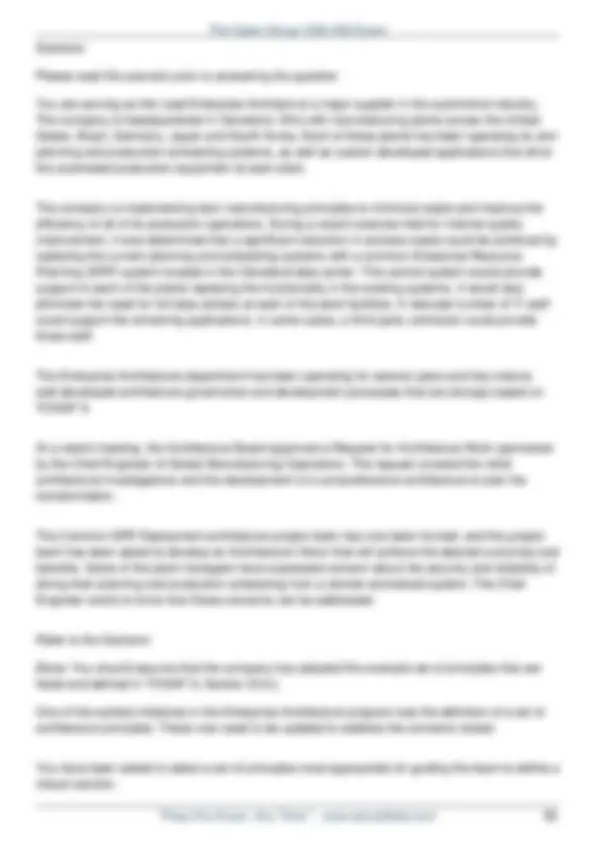
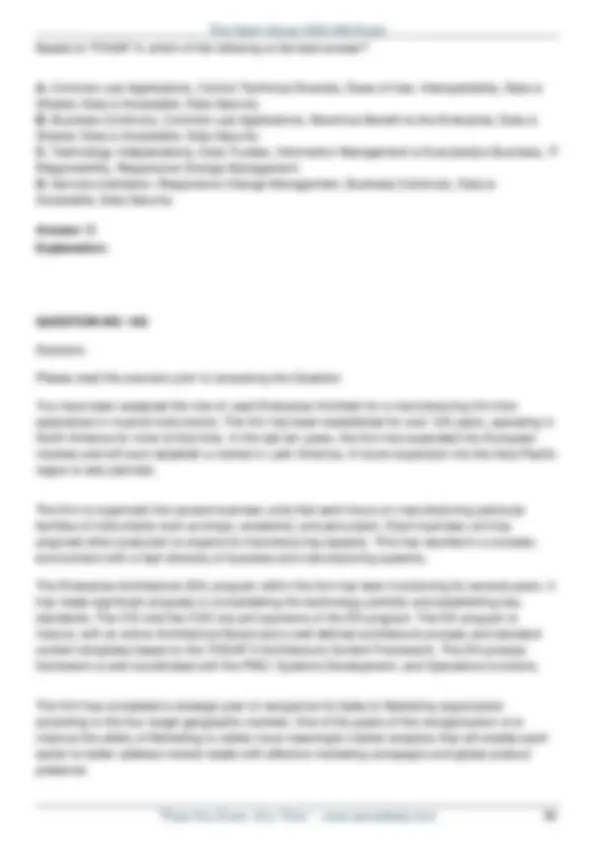
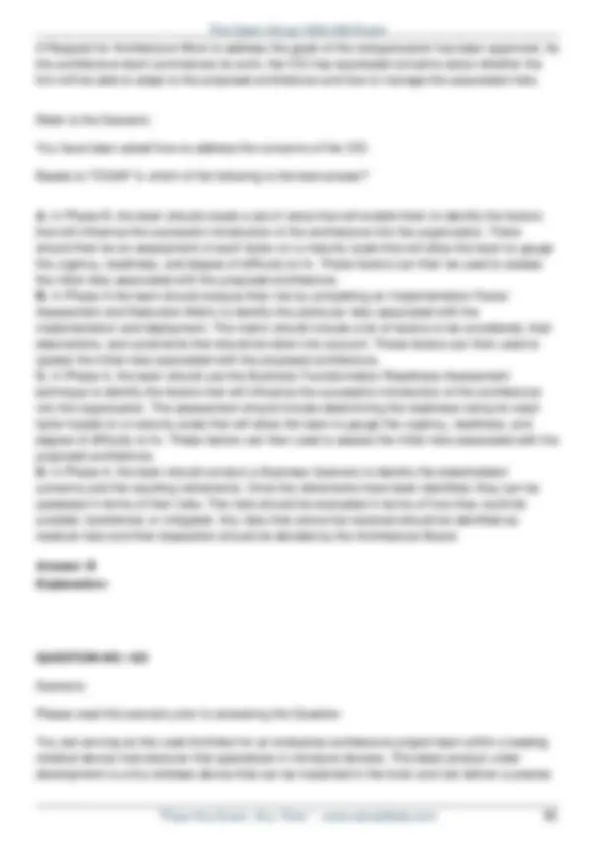
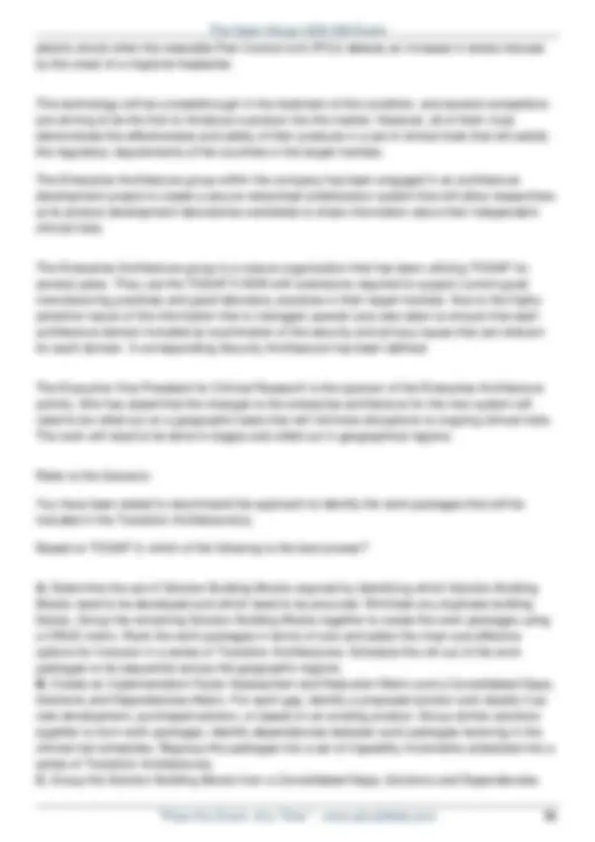
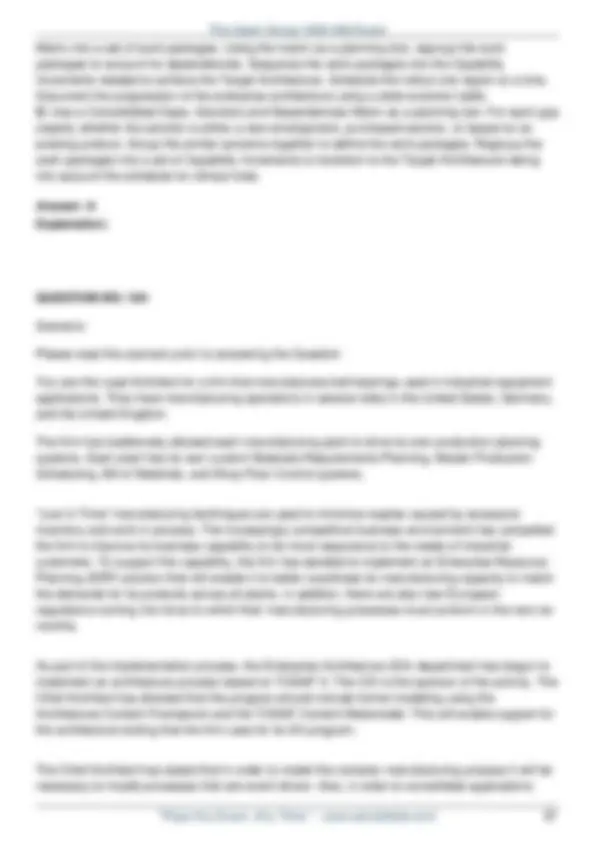
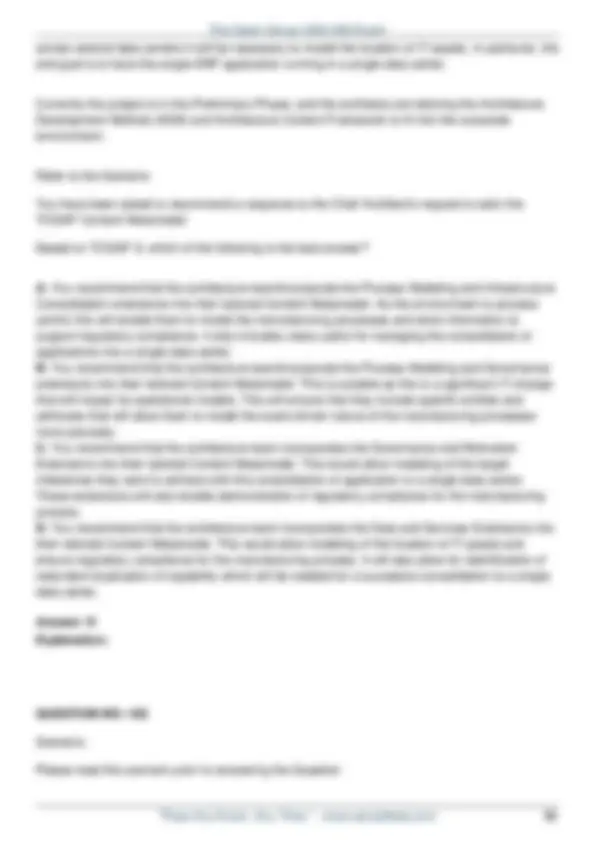
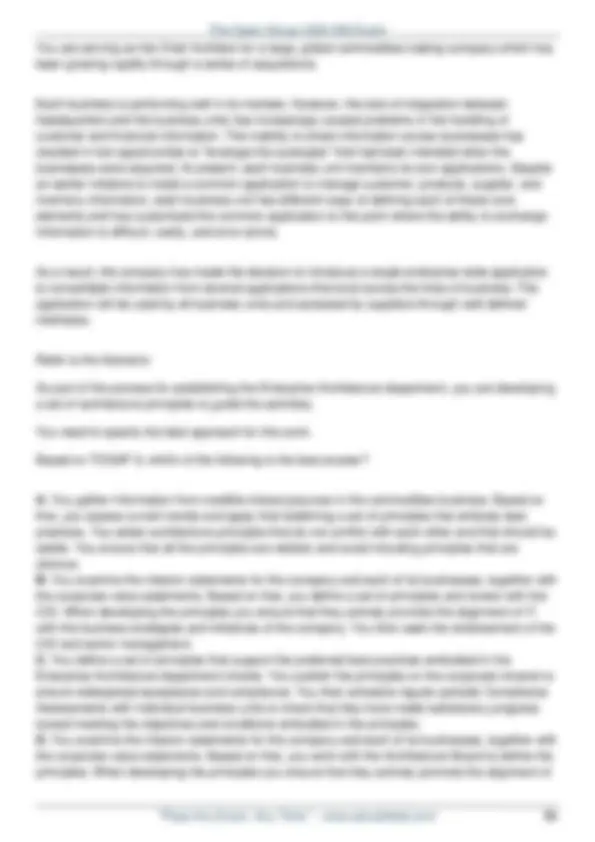
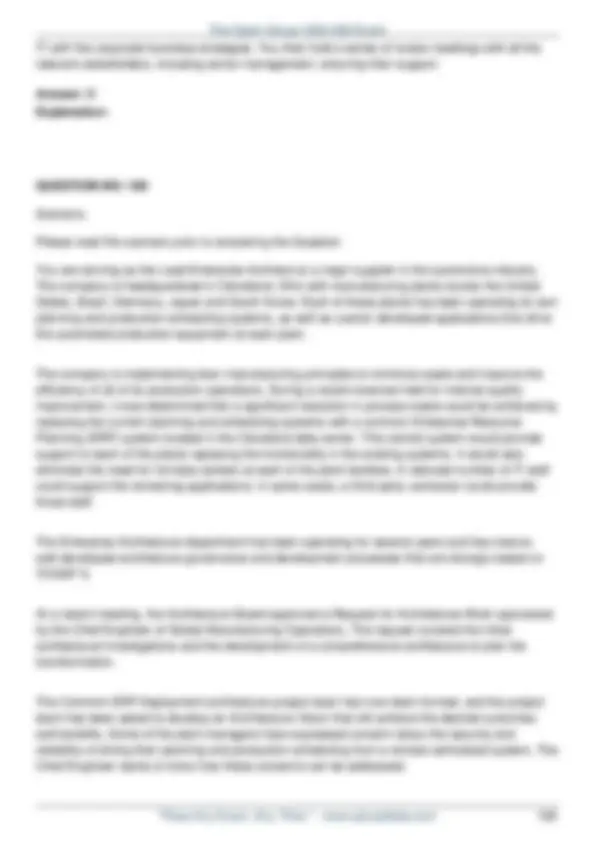


Study with the several resources on Docsity

Earn points by helping other students or get them with a premium plan


Prepare for your exams
Study with the several resources on Docsity

Earn points to download
Earn points by helping other students or get them with a premium plan
Community
Ask the community for help and clear up your study doubts
Discover the best universities in your country according to Docsity users
Free resources
Download our free guides on studying techniques, anxiety management strategies, and thesis advice from Docsity tutors
togaf 9999 document to know something
Typology: Thesis
1 / 101

This page cannot be seen from the preview
Don't miss anything!





























































































Topic 1, Part 1
QUESTION NO: 1
Which of the following TOGAF components was created to enable architects to design architectures addressing Boundaryless Information Flow?
A. The Architecture Repository B. The Enterprise Continuum C. The Integrated Information Infrastructure Model D. The TOGAF Technical Reference Model
Answer: C Explanation:
Which of the following best describes the TOGAF Technical Reference Model?
A. It is a detailed data model that can be tailored to specific industries B. It is an example of a Common Systems Architecture C. It is a fundamental architecture upon which more specific architectures can be based D. It is a model of application components and application services software, including brokering applications
Answer: C Explanation:
Which one of the following statements about the structure of the TOGAF 9 document is true?
A. Part I, the Enterprise Continuum, describes a model for structuring a virtual repository B. Part II, the Architecture Development Method, describes the definitions of terms used in TOGAF, and the changes between versions of TOGAF C. Part III, Tools and Support, describes a collection of guidelines and techniques used in the other parts of TOGAF D. Part VI, TOGAF Reference Models, includes a model for release management of the TOGAF specification E. Part VII, the Architecture Capability Framework, describes processes and skills to establish an enterprise function
E. To define and prioritise work packages
Answer: C Explanation:
According to TOGAF, when creating views for a particular architecture, what is the recommended first step?
A. Design a viewpoint to address all stakeholder concerns B. Develop views for the target architecture first C. Ensure completeness of the architecture D. Refer to existing libraries of viewpoints, to identify one for re-use
Answer: D Explanation:
Which of the following architectures in the Architecture Continuum contains the most re-usable architecture elements?
A. Common Systems Architectures B. Foundation Architectures C. Industry Architectures D. Organization-Specific Architectures
Answer: B Explanation:
Which of the following describes the Architecture Vision document?
A. A description of individual change increments showing progression from the baseline to target architecture B. A detailed schedule for implementation of the target architecture
C. A high level description of the baseline and target architectures D. A joint agreement between the development team and sponsor on the deliverables and quality of an architecture E. A set of rules and guidelines to support fulfilling the mission of the organization
Answer: C Explanation:
According to TOGAF, which of the following best describes how the Enterprise Continuum is used in organizing and developing an architecture?
A. It is used to coordinate with the other management frameworks in use B. It is used to describe how an architecture addresses stakeholder concerns C. It is used to identify and understand business requirements D. It is used to provide a system for continuous monitoring E. It is used to structure re-usable architecture and solution assets
Answer: E Explanation:
What document is sent from the sponsoring organization to the architecture organization to trigger the start of an ADM cycle?
A. Architecture Contract B. Architecture Definition Document C. Architecture Vision D. Request for Architecture Work E. Statement of Architecture Work
Answer: D Explanation:
According to TOGAF, which of the following best describes Architecture Governance?
According to TOGAF, which of the following best describes the purpose of a Compliance Assessment?
A. To ensure that architecture information is communicated to the right stakeholders at the right time B. To govern the architecture throughout its implementation process C. To provide a high-level view of the end architecture product D. To show progression of change from the Baseline Architecture to the Target Architecture
Answer: B Explanation:
Which of the following describes a key objective of the Technology Architecture Phase?
A. To define the solution architecture needed to support the Application Architecture B. To define technology components into a set of technology platforms C. To define the Transition Architectures needed to achieve the Target Architecture D. To develop a migration plan to deliver incremental capabilities E. To select a set of technology products that will form the basis of a solution architecture
Answer: B Explanation:
Which one of the following statements best describes why the ADM should be adapted?
A. To align it closer to the business B. To make the use more realistic C. To move through the cycle faster D. To suit the specific needs of the enterprise
Answer: D Explanation:
In which phase of the TOGAF ADM are Gap Analysis results from earlier phases consolidated?
A. Phase D B. Phase E C. Phase F D. Phase G E. Phase H
Answer: B Explanation:
Which of the following best describes the purpose of a business scenario?
A. To define and plan an enterprise architecture transformation based on Capability-Based Planning B. To develop a set of general rules and guidelines for the architecture being developed C. To develop a set of security guidelines for the architecture being developed D. To help identify and understand the business requirements that an architecture must address E. To identify and mitigate the risks when implementing an architecture project
Answer: D Explanation:
According to TOGAF, which of the following best describes the classification of architectural change in the case where multiple server systems are being consolidated to a single system?
A. A bottom-up change to enhance operational capability B. An incremental change handled via change management techniques C. A re-architecting change that puts the whole architecture through an ADM cycle D. A revision change of the enterprise architecture E. A simplification change handled via change management techniques
Answer: E Explanation:
Which one of the following is an objective of Phase A of the TOGAF ADM?
A. To allocate the resources needed to implement the architecture project B. To define the framework that is going to be used to develop the enterprise architecture C. To define an IT Strategy that maps out the technology infrastructure D. To prepare a Solution Architecture for the enterprise E. To secure formal approval to proceed
Answer: E Explanation:
Complete the sentence. TOGAF 9 Part III provides a set of resources that can be used to adapt and modify the ____________.
A. Architecture Capability B. Architecture Development Method C. Architecture Landscape D. Architecture Repository E. Enterprise Continuum
Answer: B Explanation:
Which of the following best describes how TOGAF defines an enterprise?
A. Any collection of organizations that has a common set of goals B. Any corporation with more than 10,000 employees C. Any organization involved in commerce D. Any organization whose stock is traded E. Any set of organizations based at the same geographic location
Answer: A
Explanation:
Which of the following is an objective of Phase B, Business Architecture?
A. To confirm the ability of the enterprise to undergo change B. To demonstrate how stakeholder concerns are addressed in the Business Architecture C. To develop a Target Technology Architecture to support the business D. To finalize the Architecture Vision and Architecture Definition documents E. To maximize the business value from the architecture
Answer: B Explanation:
Which section of the TOGAF template for Architecture Principles should highlight the business benefits for adhering to the principle?
A. Implications B. Name C. Rationale D. Statement
Answer: C Explanation:
Which of the following is defined by TOGAF as a representation of a system from the perspective of a related set of concerns?
A. Architecture Building Block B. Capability Architecture C. Statement of Work D. View E. Viewpoint
Answer: A Explanation:
Which one of the following categories from the Document Categorization model consists of the normative parts of TOGAF which are considered central to its usage?
A. TOGAF Core B. TOGAF Mandated C. TOGAF Recommended D. TOGAF Referenced E. TOGAF Supporting
Answer: B Explanation:
Which one of the following statements about TOGAF Building Blocks is true?
A. Building blocks at a functional level are known as Solutions Building Blocks B. Solutions Building Blocks are selected in Phases A, B, C and D C. The specification of a building block should be loosely coupled to its implementation D. The gap analysis technique should be used to identify building blocks for re-use
Answer: C Explanation:
What part of the Architecture Repository shows the building blocks that are currently in use within the organization?
A. Architecture Landscape B. Architecture Metamodel C. Governance Log D. Reference Library
E. Standards Information Base
Answer: A Explanation:
Which one of the following is responsible for the acceptance and sign-off of an Architecture Compliance review?
A. Architecture Board B. Architecture Review Co-ordinator C. CIO D. Lead Enterprise Architect E. Project Leader
Answer: A Explanation:
According to TOGAF, in which phase of the ADM should an initial assessment of business transformation readiness occur?
A. Preliminary Phase B. Phase A C. Phase B D. Phase F E. Phase G
Answer: B Explanation:
Complete the sentence. A gap analysis will enable the architect to do all of the following except _____.
Which of the following best describes the meaning of "Initial Level of Risk" in Risk Management?
A. The categorization after implementation of mitigating actions B. The categorization after initial risk assessment C. The categorization after mitigation and residual risk assessment D. The categorization before determining and implementing mitigating actions E. The categorization before risk identification
Answer: D Explanation:
Complete the sentence. According to TOGAF, a view is used to describe how the _____ of a stakeholder are being met.
A. concerns B. constraints C. interests D. perspective E. requirements
Answer: A Explanation:
Complete the sentence. The Architecture Development Method produces content to be stored in the Repository, which is classified according to the __________________.
A. ADM Guidelines and Techniques B. Architecture Capability Framework C. Architecture Capability Model D. Enterprise Continuum E. Standards Information Base
Answer: D Explanation:
Which of the following best describes the state of architecture artifacts as a project progresses through ADM Phases A to D?
A. The artifacts are transformed into solution architectures B. The artifacts become increasingly product focused C. The artifacts become increasingly generic and re-usable D. The artifacts evolve from generic architectures to organization-specific architectures E. The artifacts evolve from common systems architectures to foundation architectures
Answer: D Explanation:
Which of the following describes the Phase H classification for an Incremental change?
A. A change driven by a requirement to derive additional value from the existing investment B. A change driven by a requirement to increase investment in order to create new value for exploitation C. A change driven by a requirement to reduce investment D. A change driven by a requirement to re-align with the business strategy
Answer: A Explanation:
Which one of the following statements about viewpoints is correct?
A. A viewpoint is always specific to an architecture B. A viewpoint is used to create views in Phases E and F C. A viewpoint is used as a template to create a view D. A viewpoint is what a stakeholder sees
D. Strategic Architecture E. Tactical Architecture
Answer: D Explanation:
A key step in validating a proposed target architecture is to consider what may have been forgotten. What technique does TOGAF recommend to address this issue?
A. Business Transformation Readiness Assessment B. Business Value Assessment Technique C. Capability-Based Planning D. Communications and Stakeholder Management E. Gap Analysis
Answer: E Explanation:
Complete the sentence. In the Preliminary Phase, all of the following are part of preparing the organization to undertake successful enterprise architecture, except __________.
A. defining architecture principles B. defining relationships between management frameworks C. defining the enterprise D. evaluating the enterprise architecture maturity E. identifying stakeholders and their concerns
Answer: E Explanation:
Which phase of the ADM establishes a set of Principles?
A. Preliminary Phase B. Phase A C. Phase D D. Phase G E. Phase H
Answer: A Explanation:
In which Phase of the ADM does the business scenario technique figure most prominently?
A. Preliminary B. Architecture Vision C. Business Architecture D. Information Systems Architectures E. Technology Architecture
Answer: B Explanation:
Which one of the following best describes the Architecture Vision document?
A. An agreement between development partners and the sponsor on architecture deliverables B. A description of how the new capability will address stakeholder concerns C. A description of the scope and approach for completion of the architecture project D. A set of quantitative statements outlining requirements on the implementation E. A set of rules and guidelines to support fulfilling the mission of the organization
Answer: B Explanation:
Which of the following best describes TOGAF?